
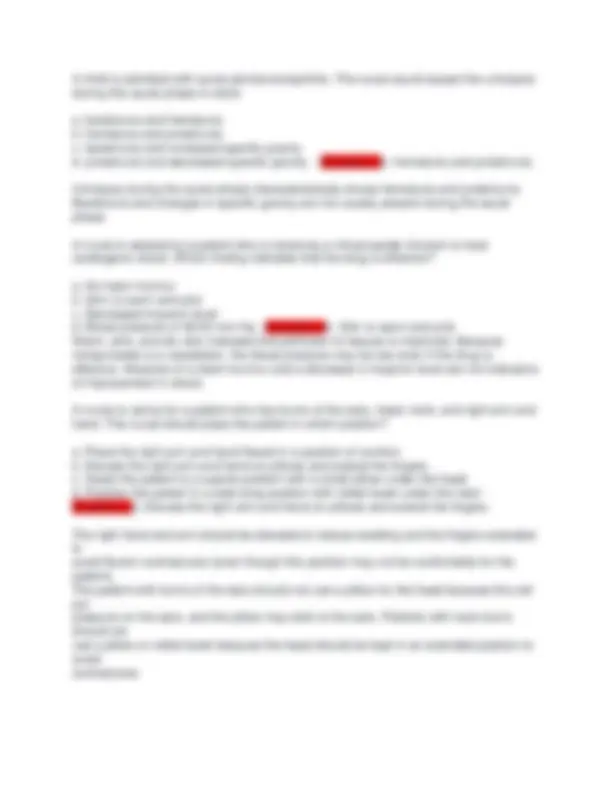
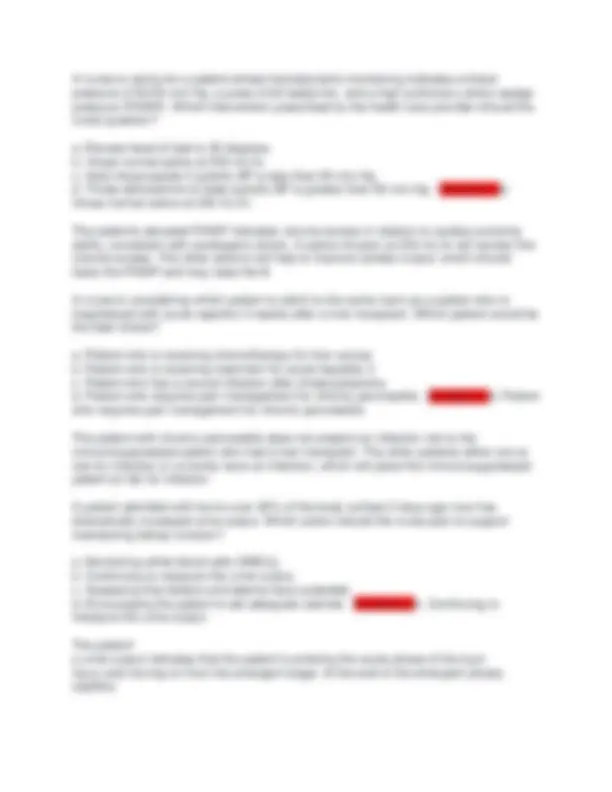
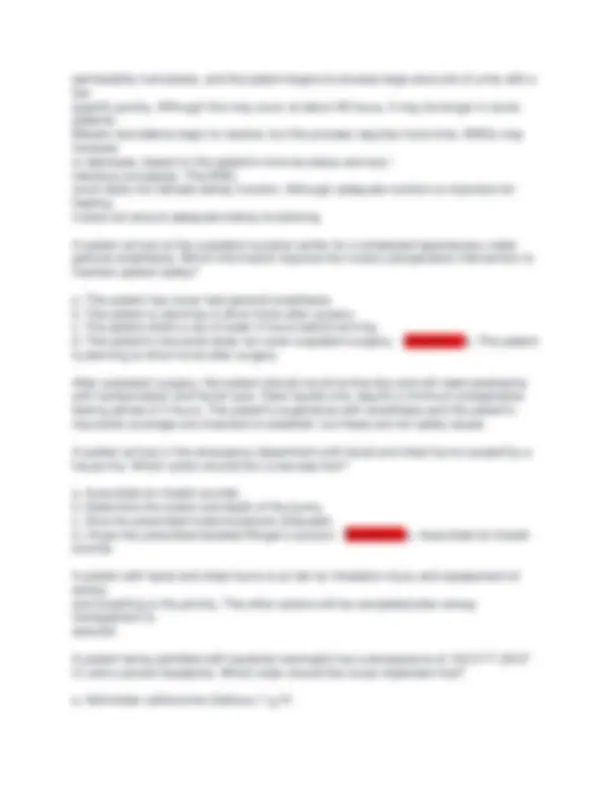
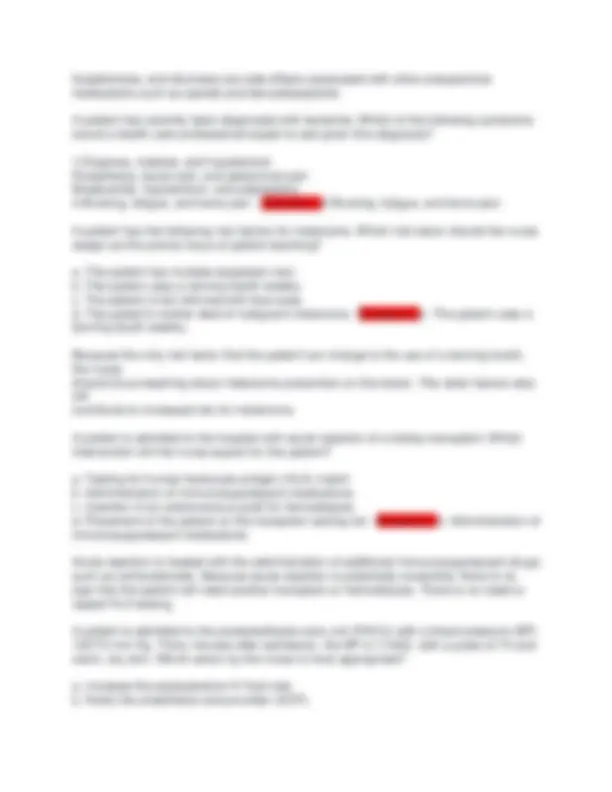
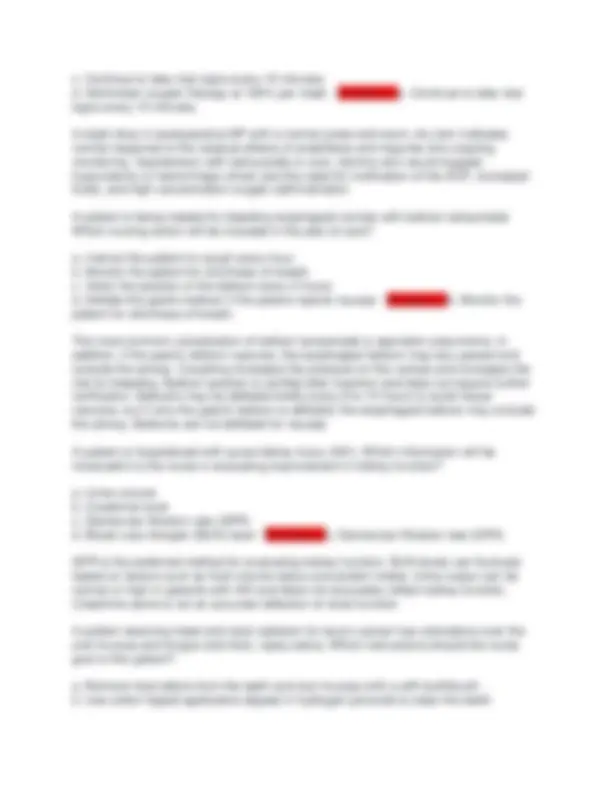
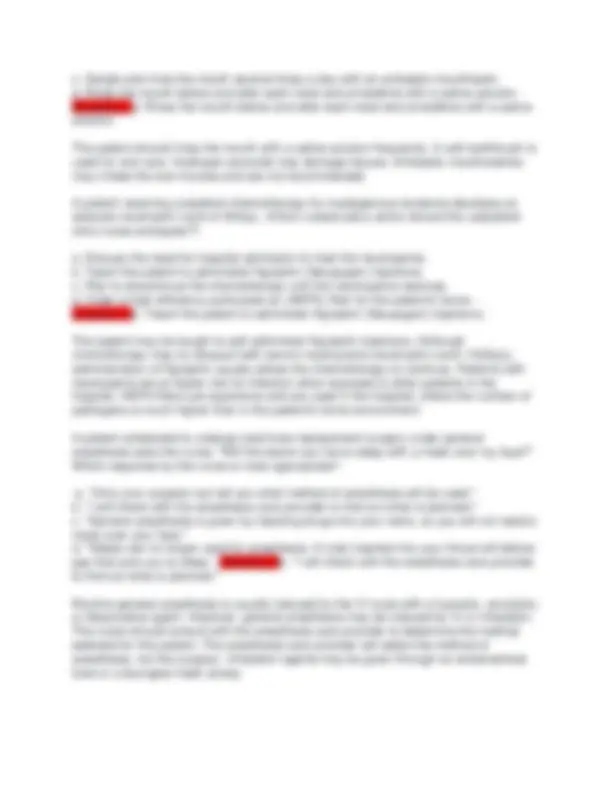
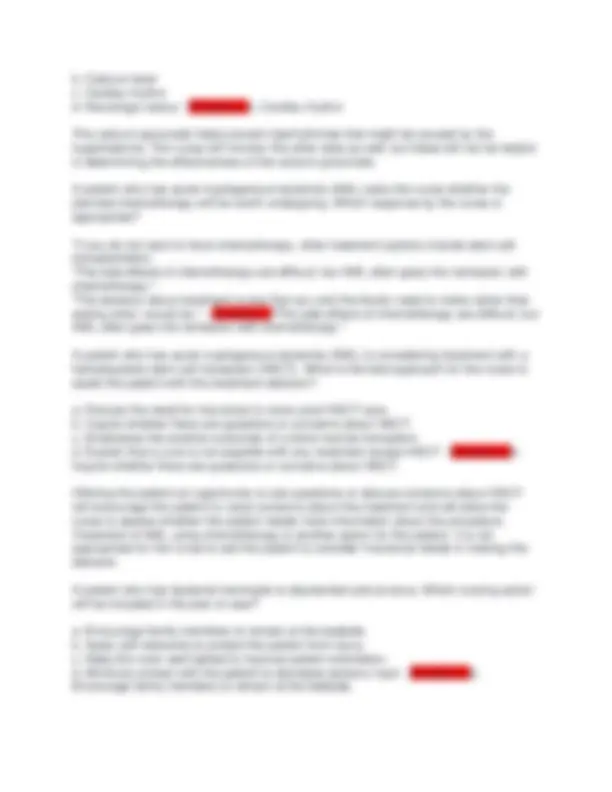
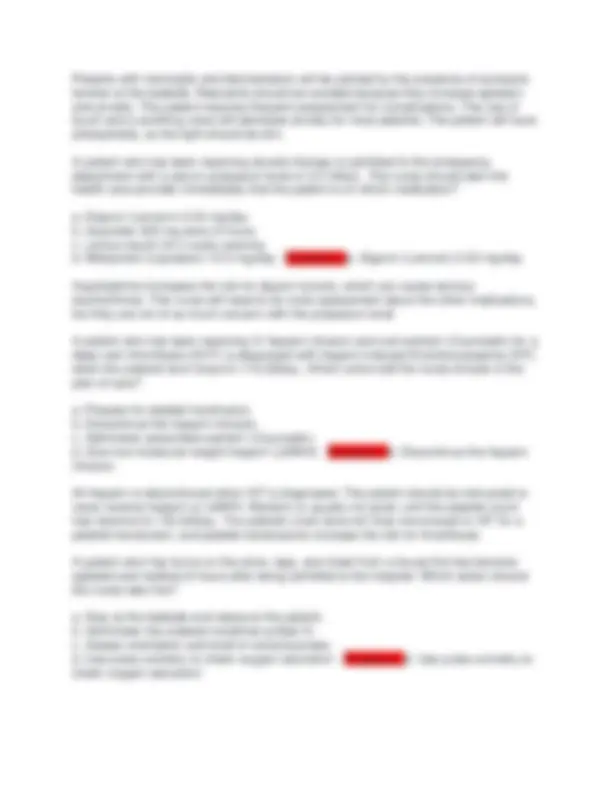
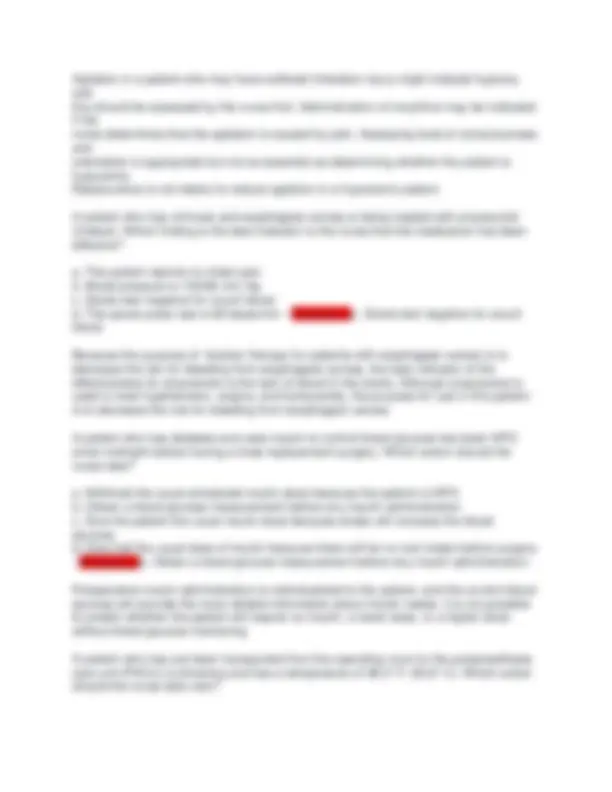
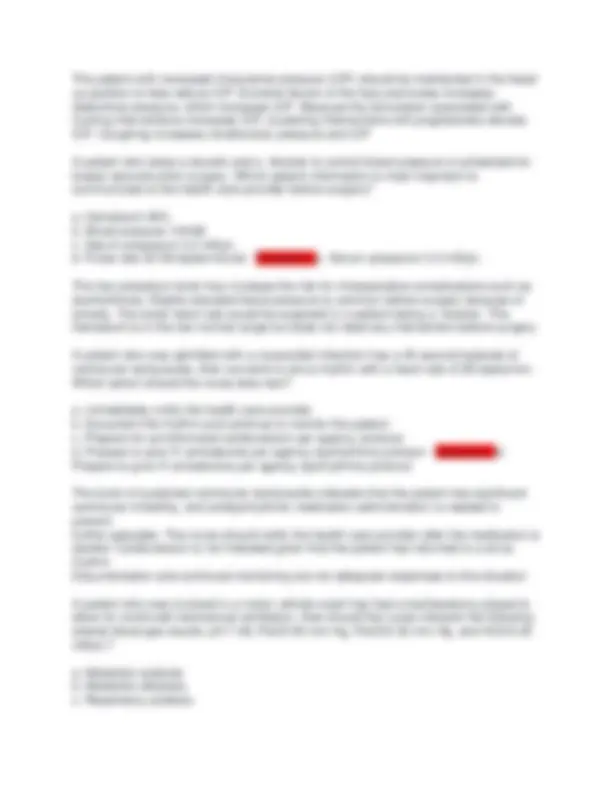
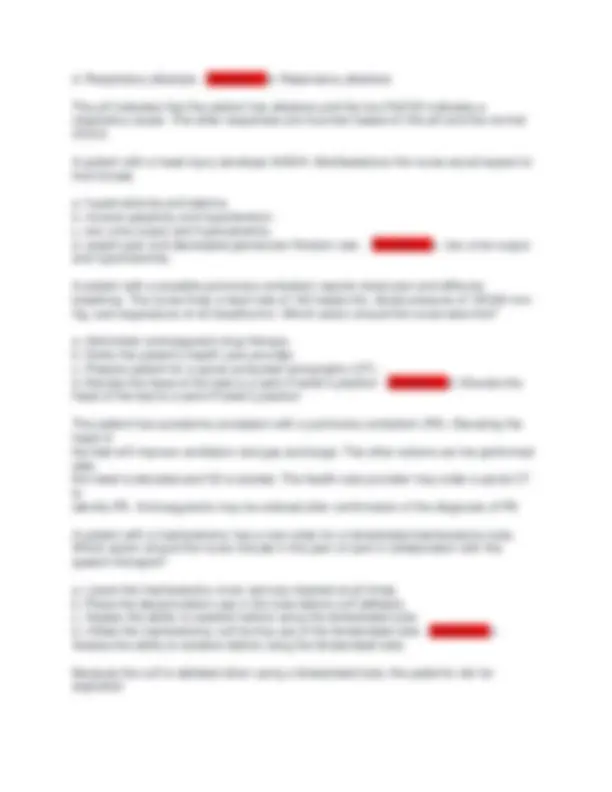
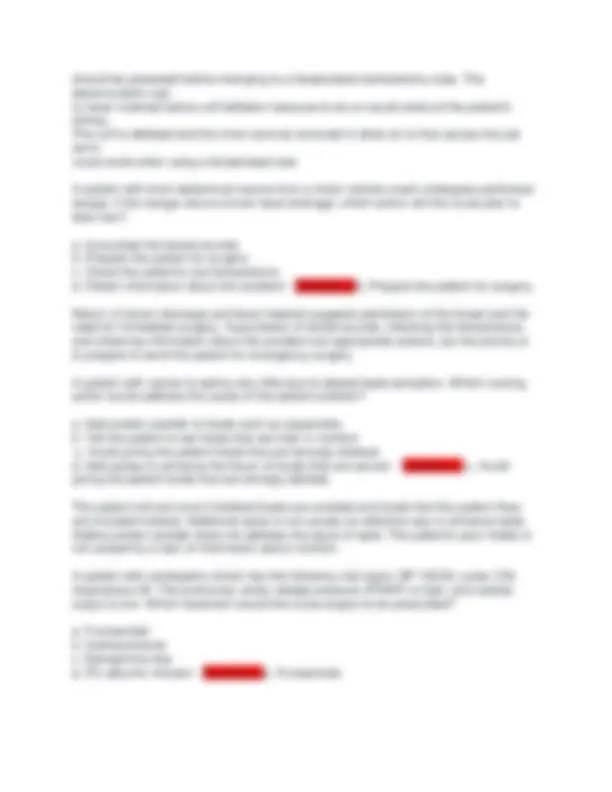
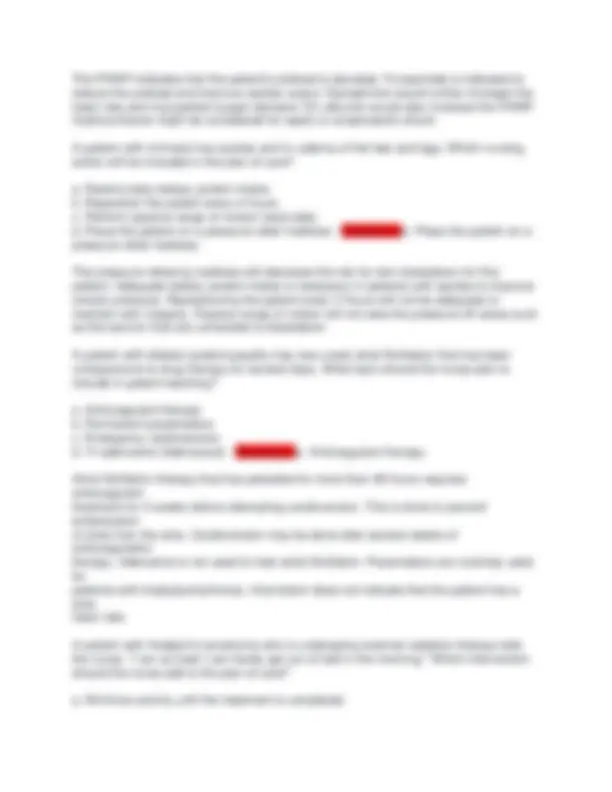
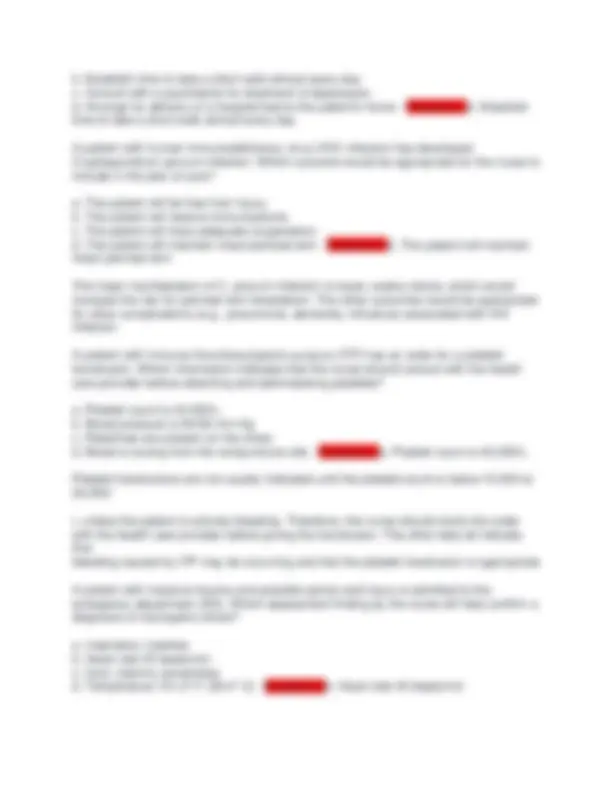
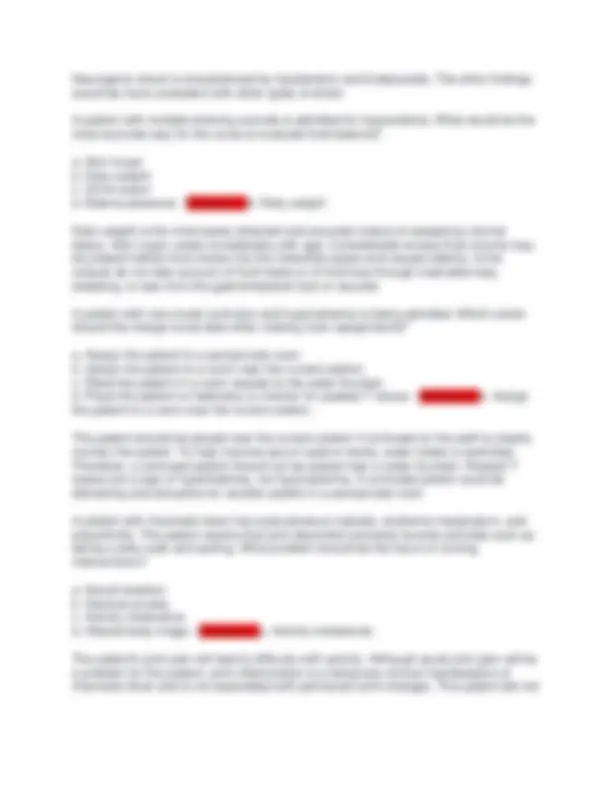
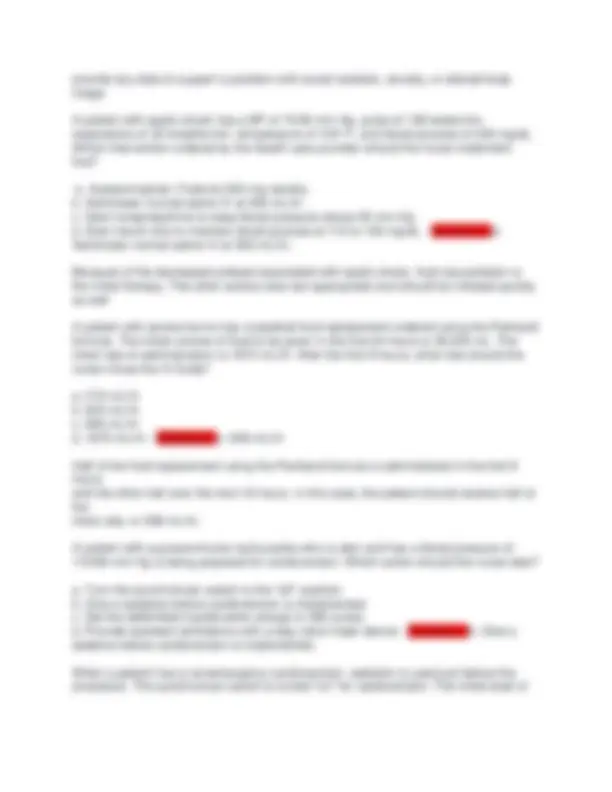
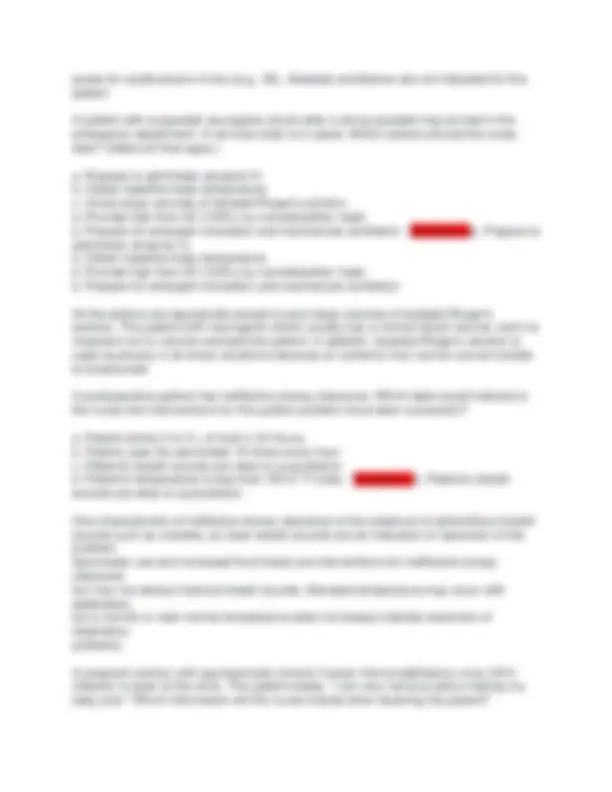
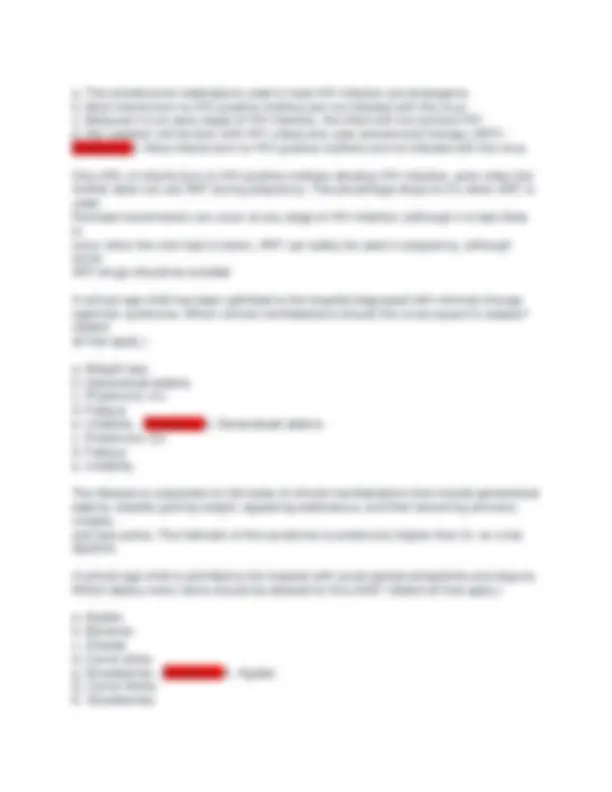
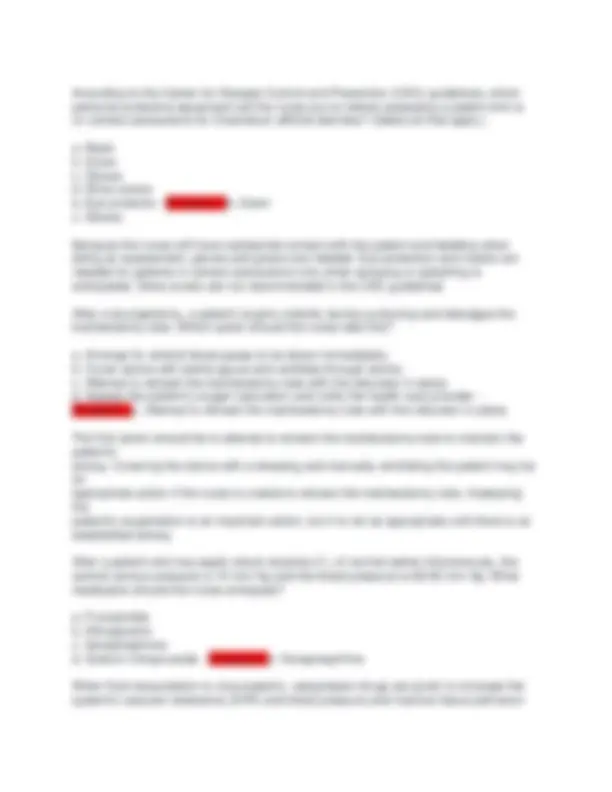
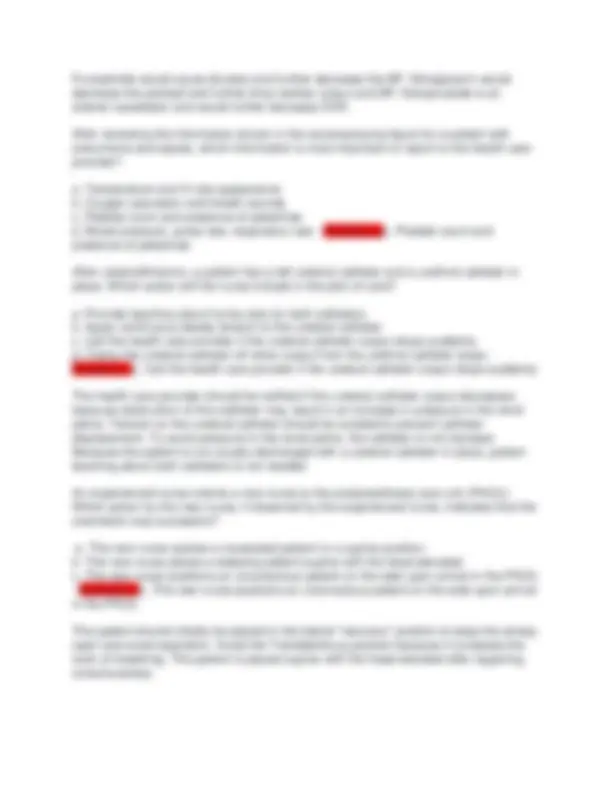
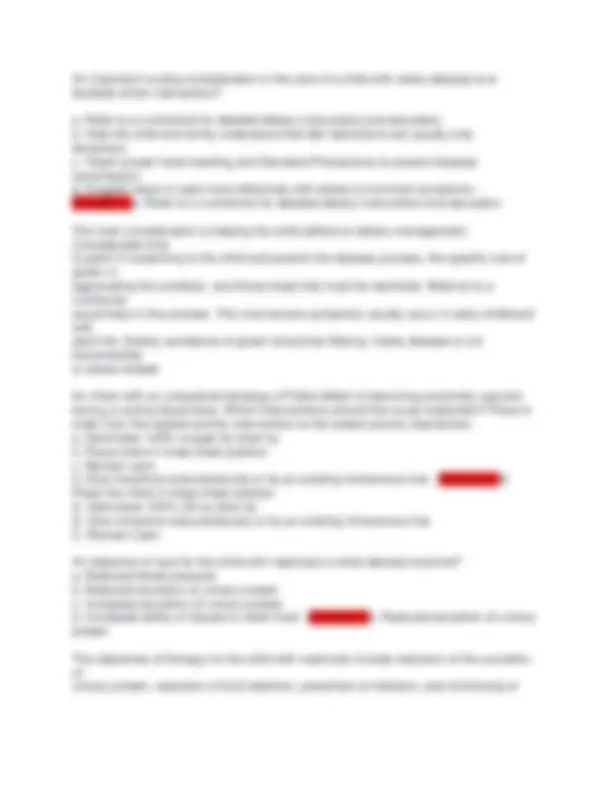
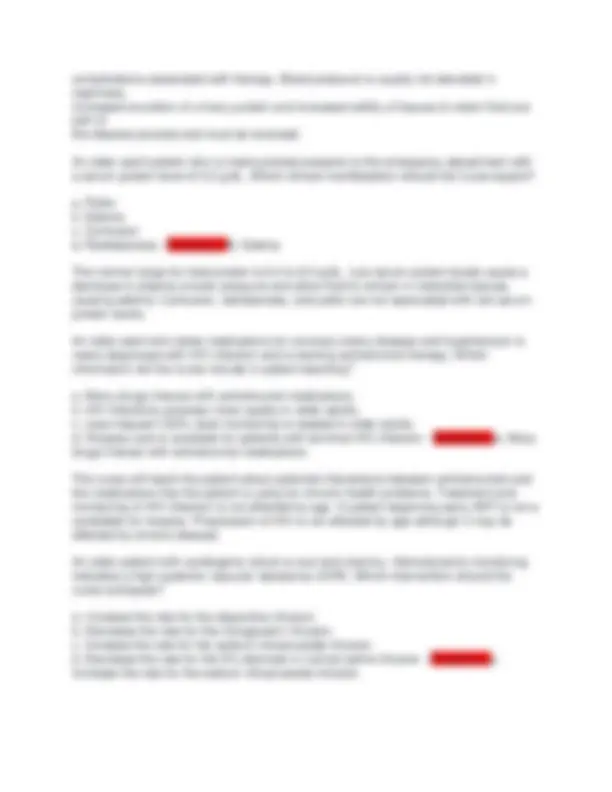
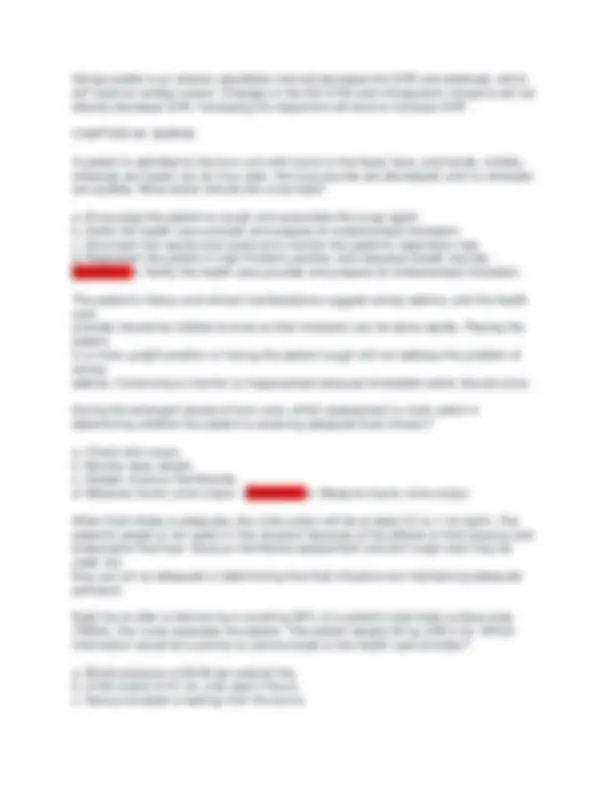
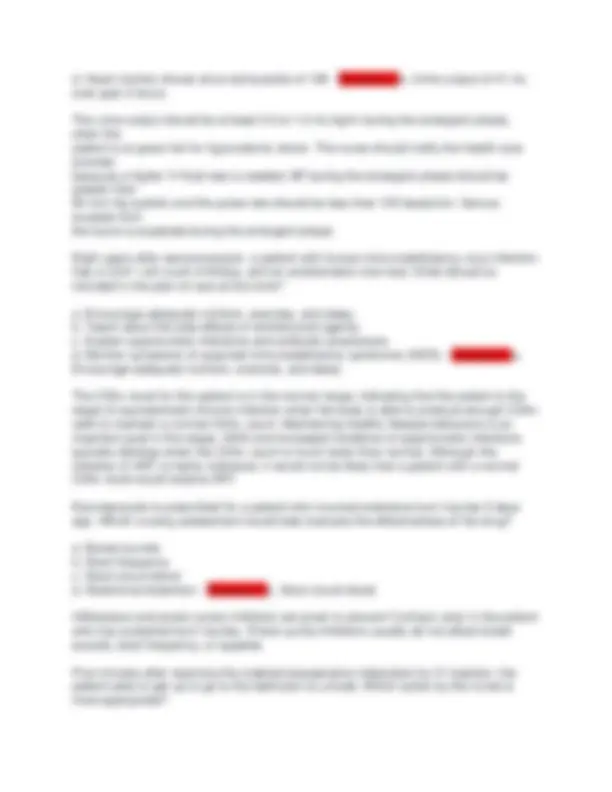
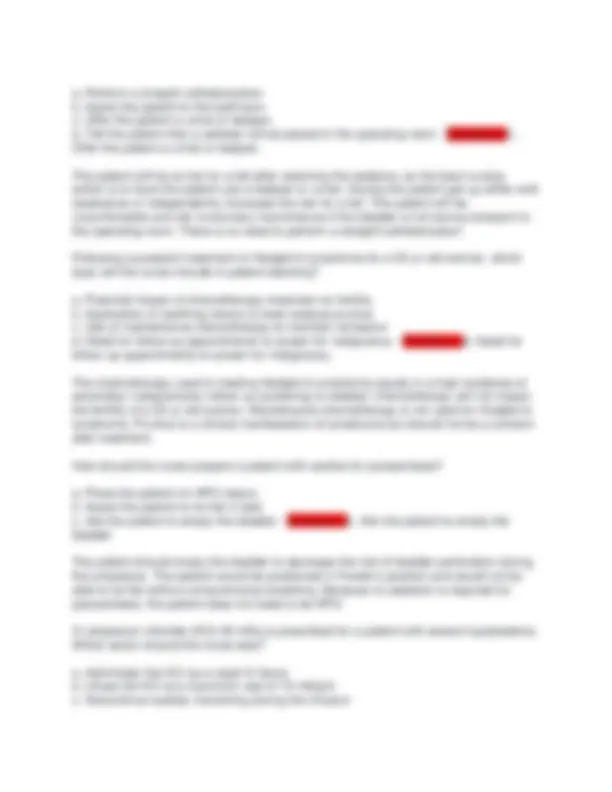
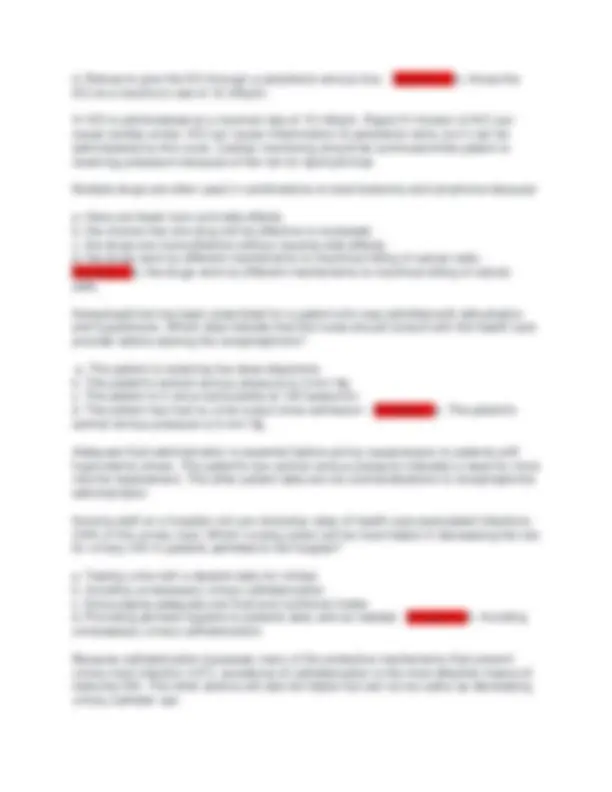
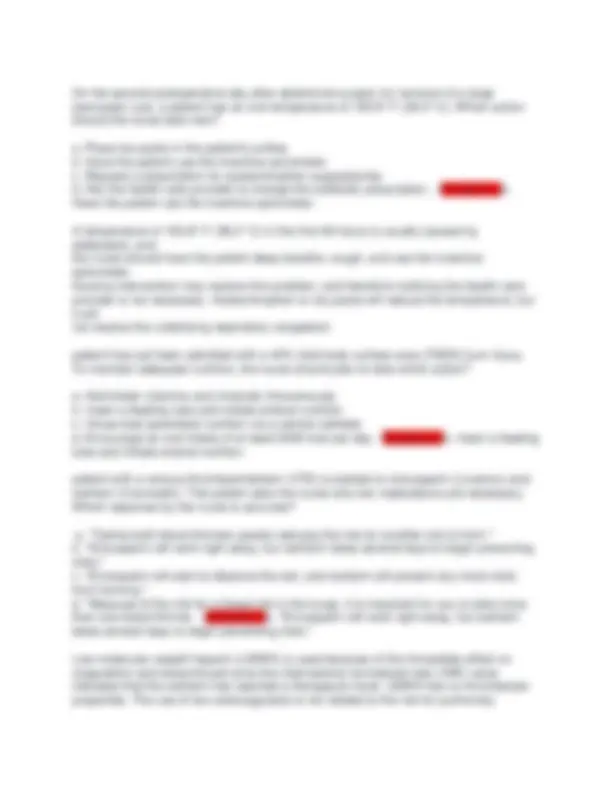
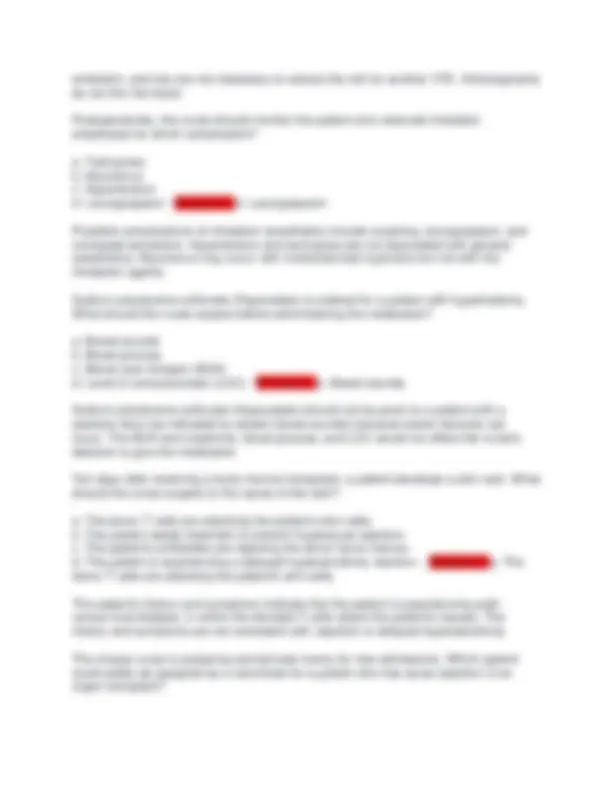
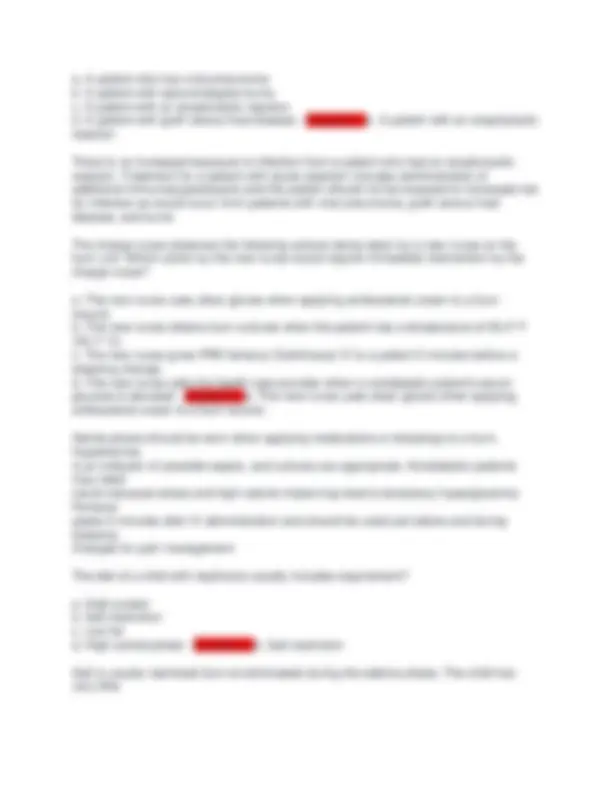
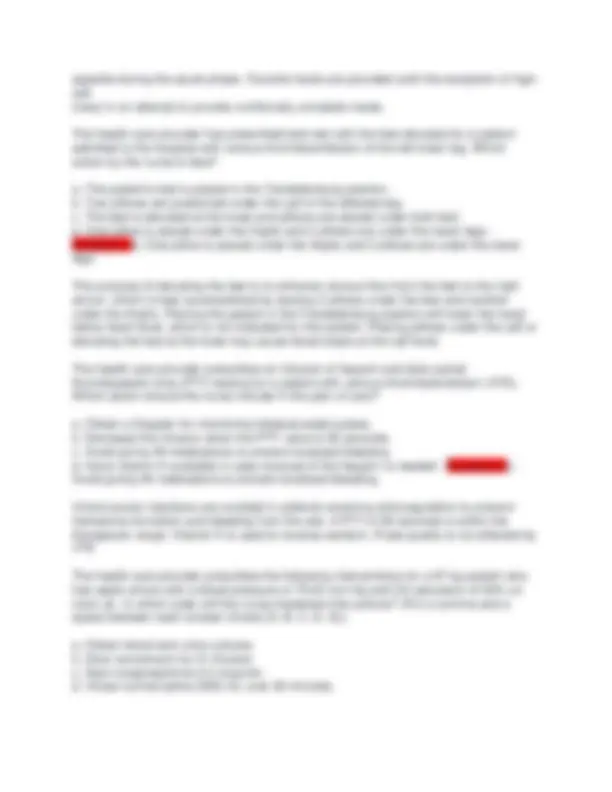
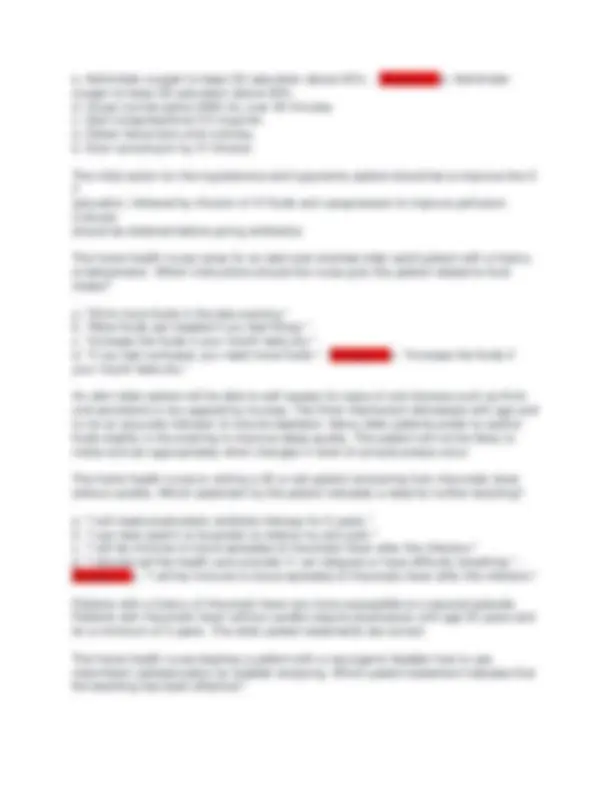
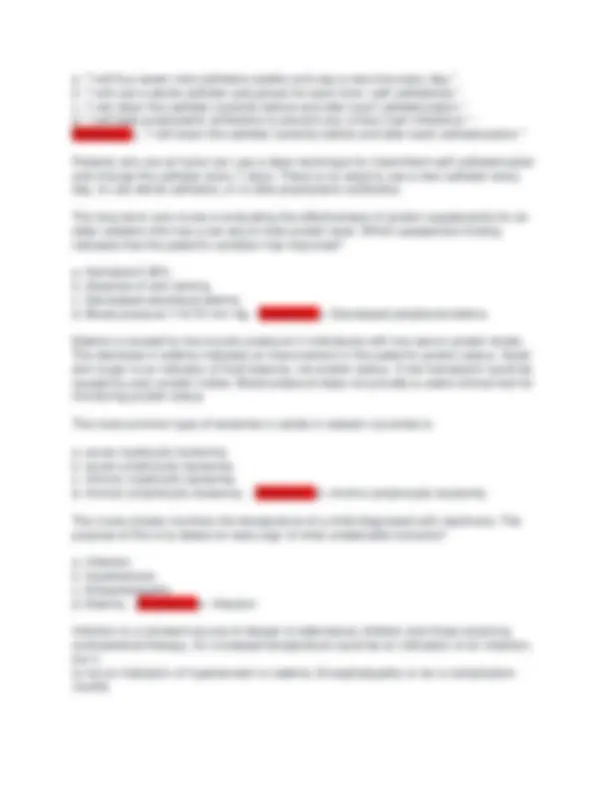
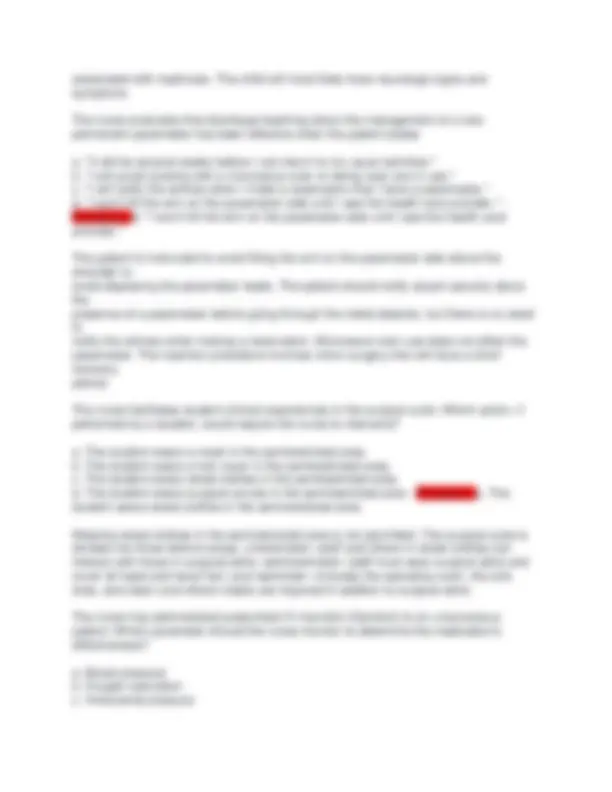
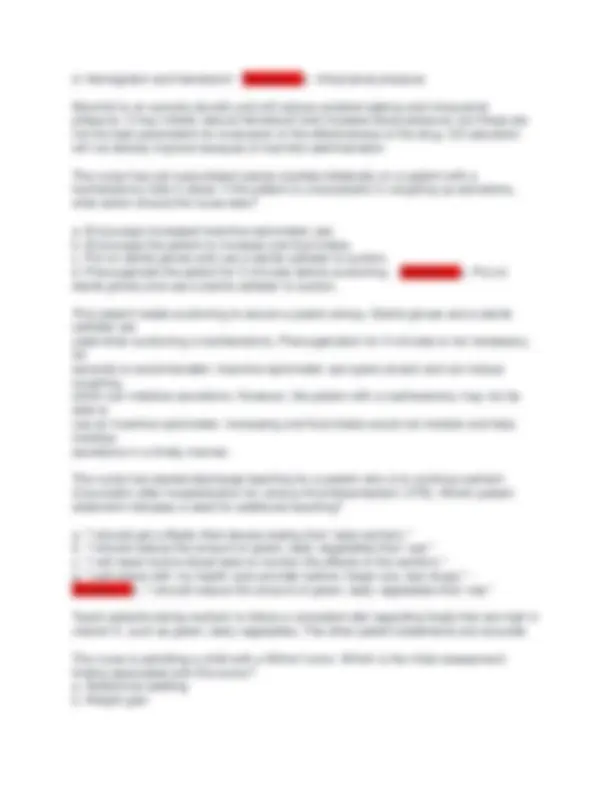
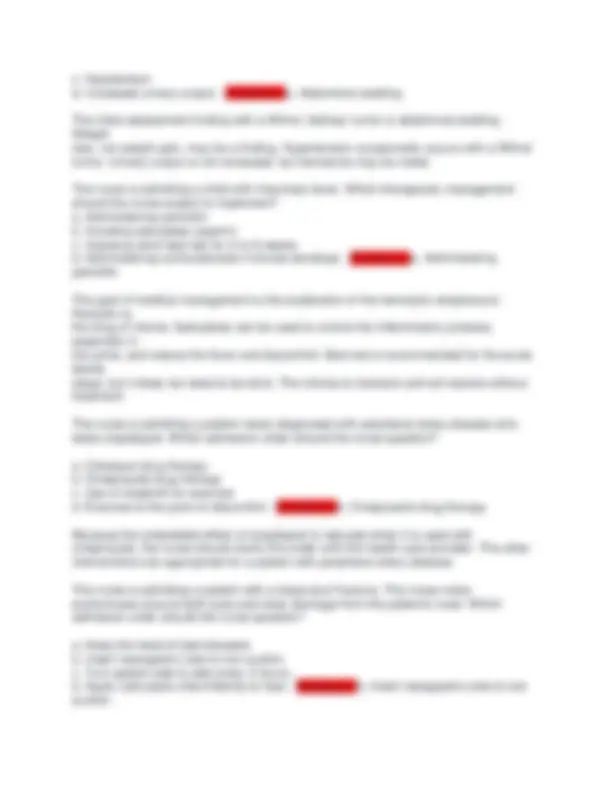
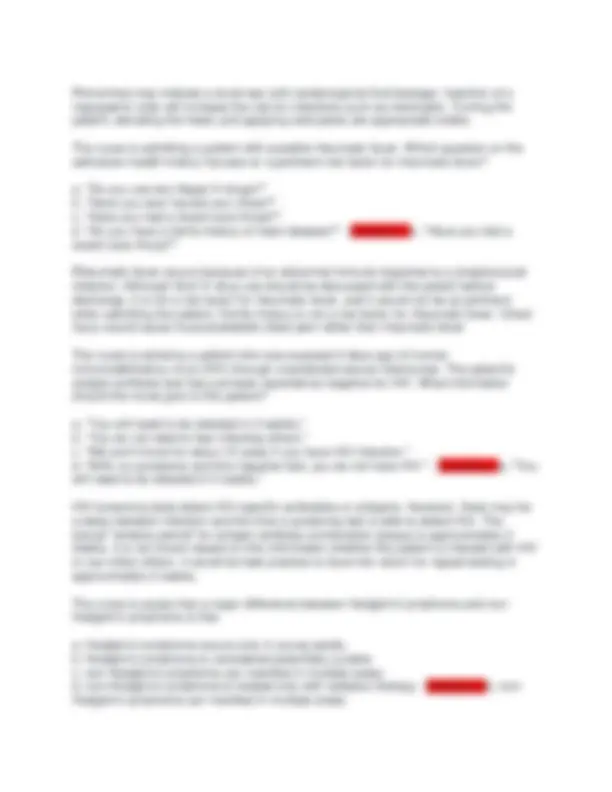
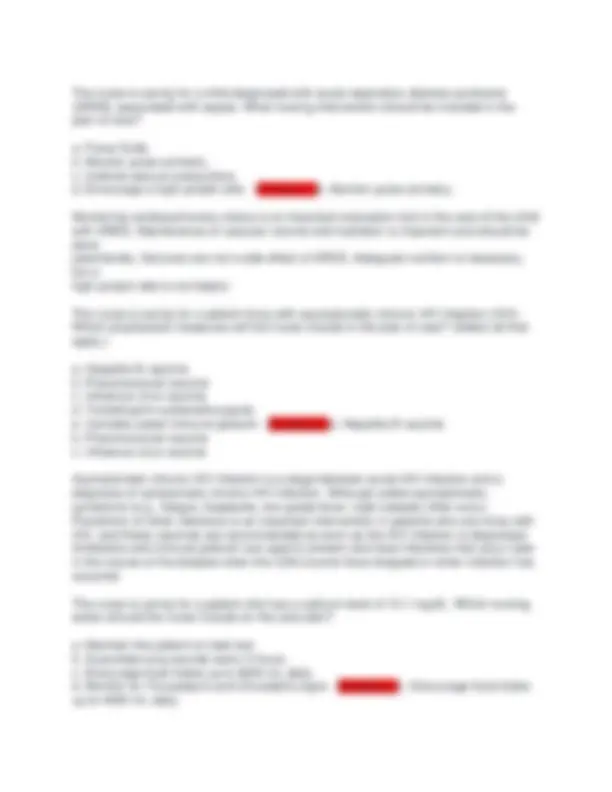
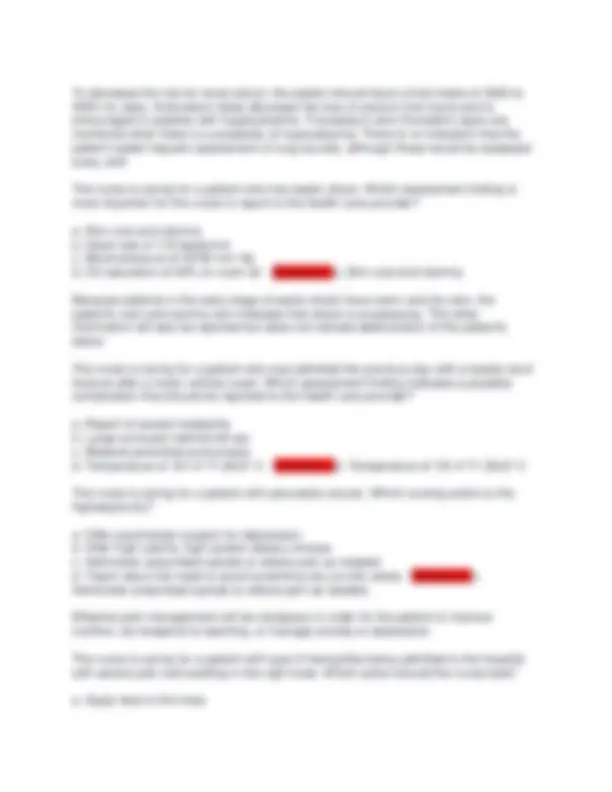
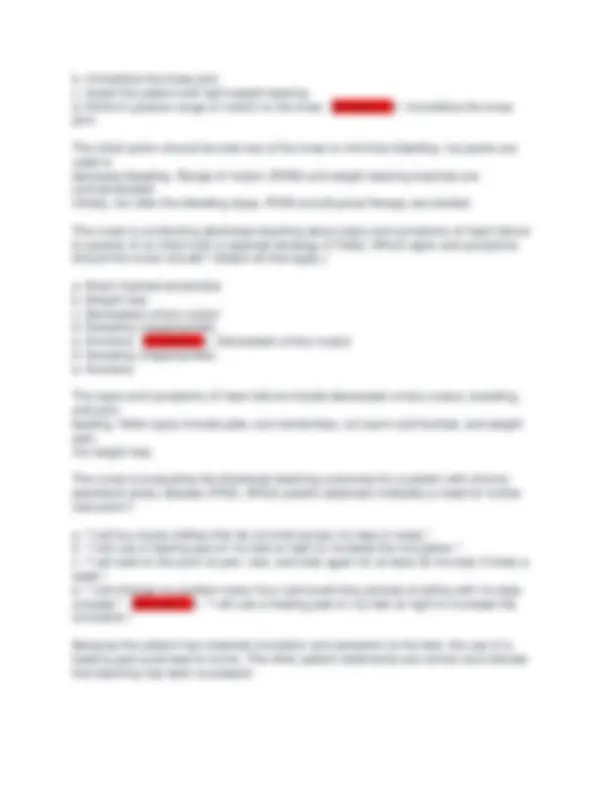
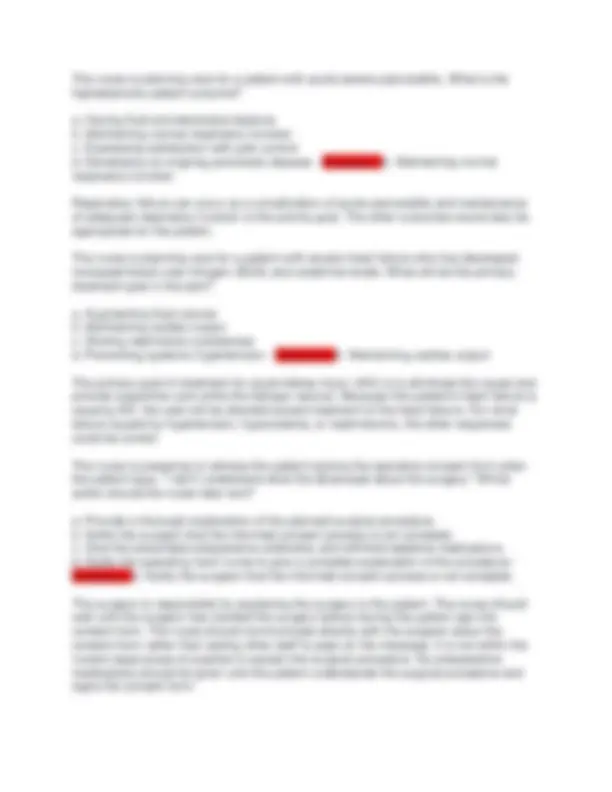
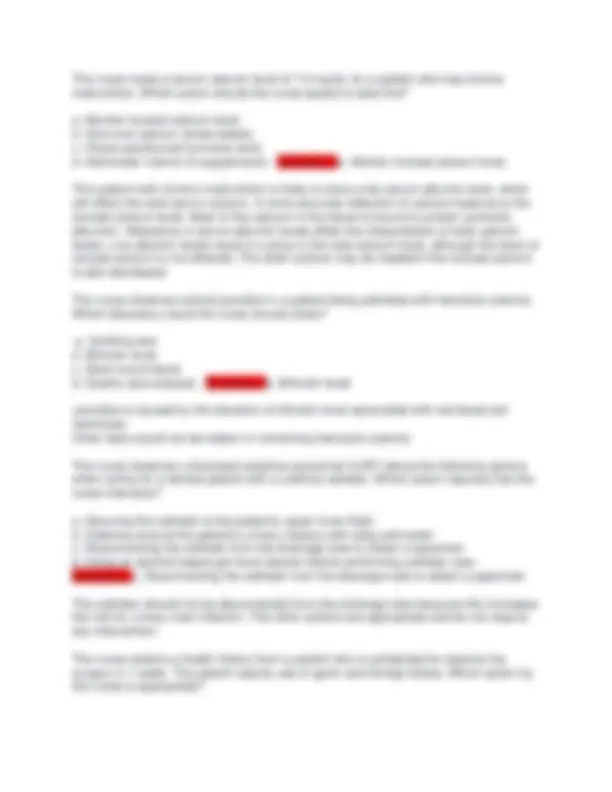
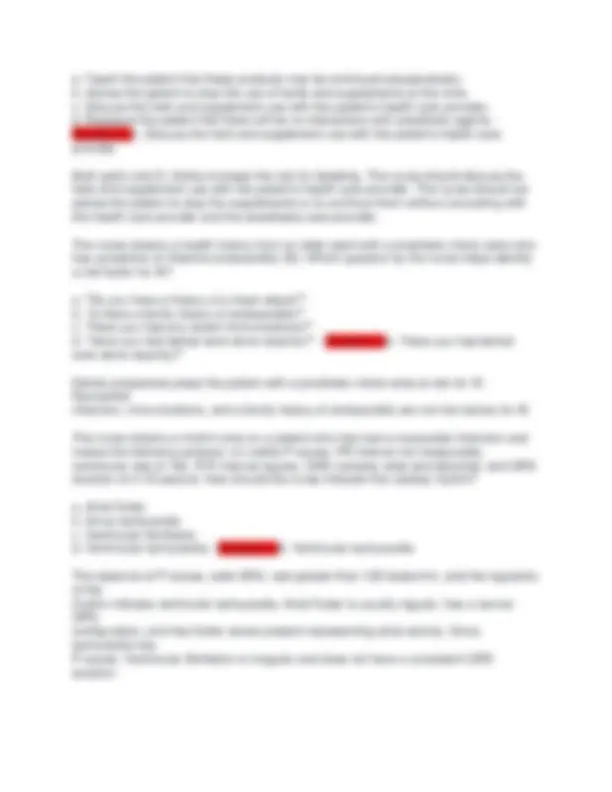
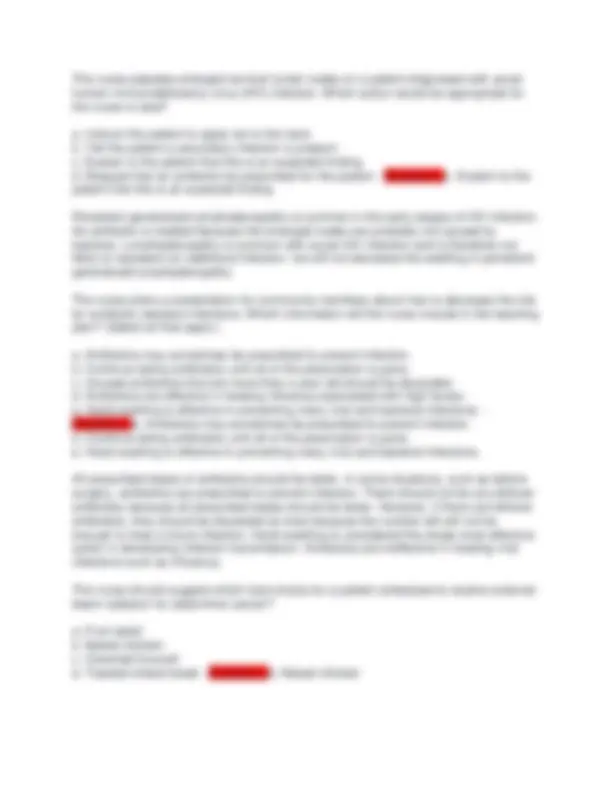
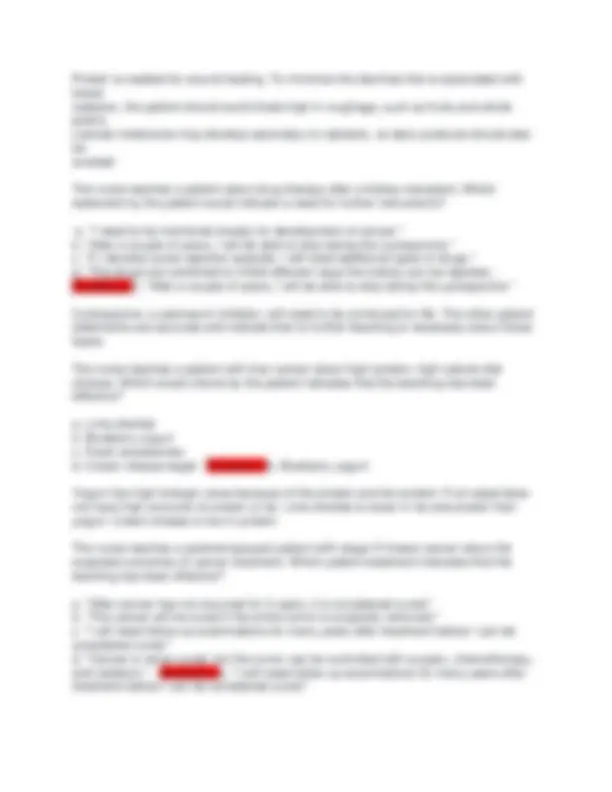
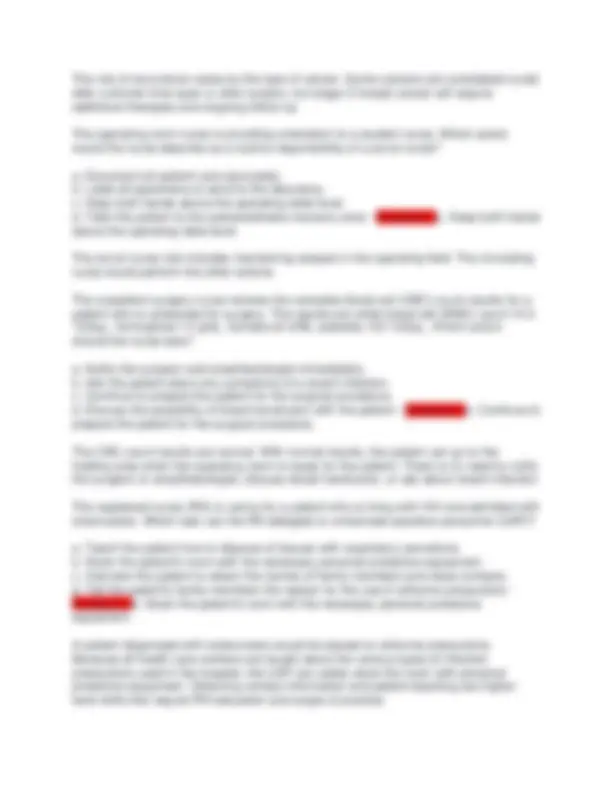
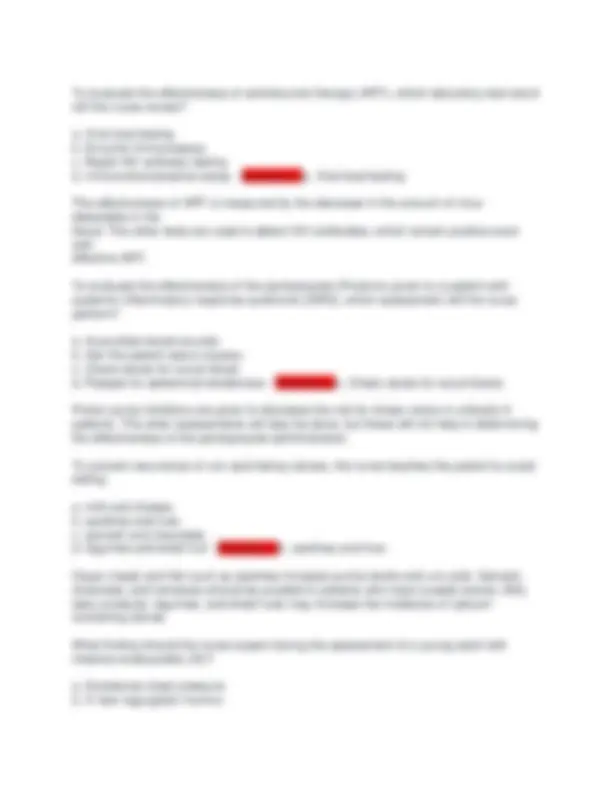
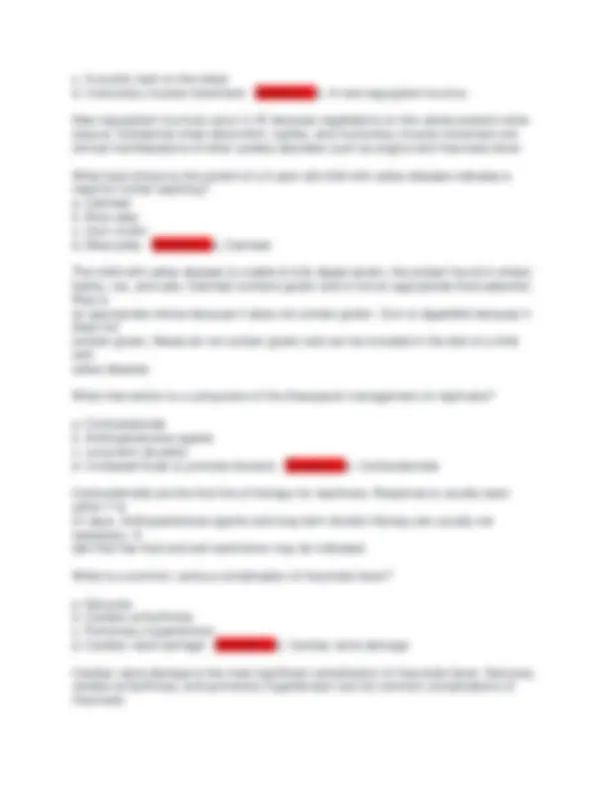
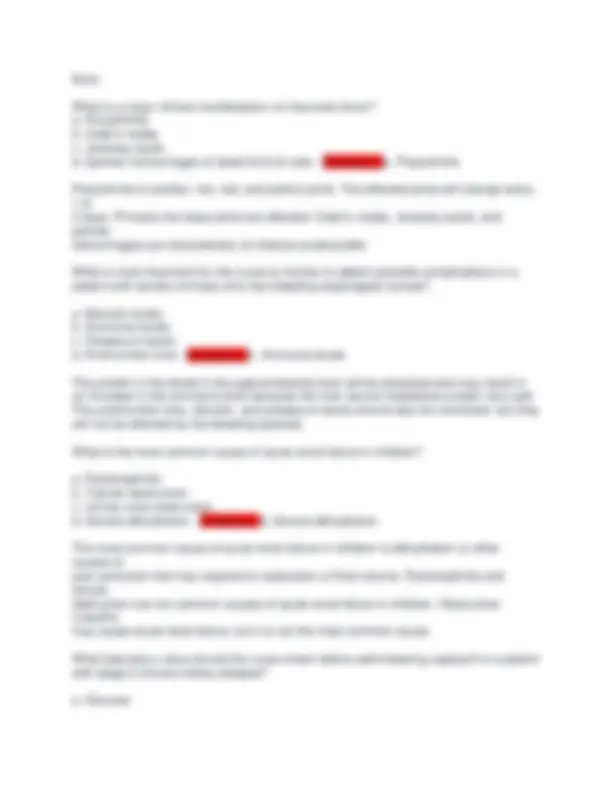
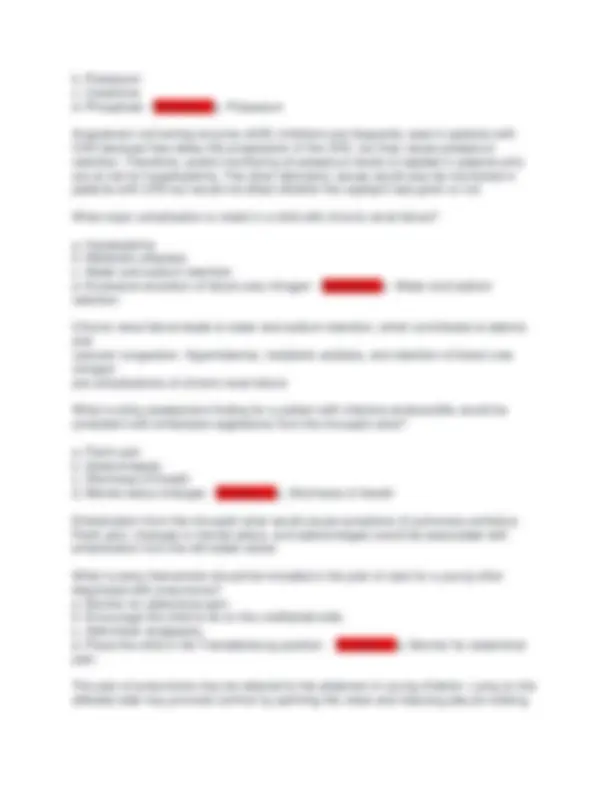
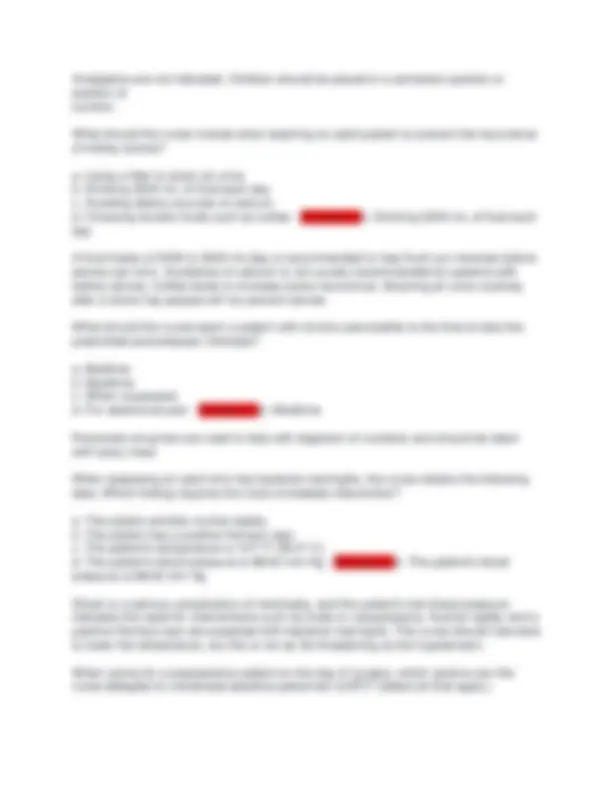
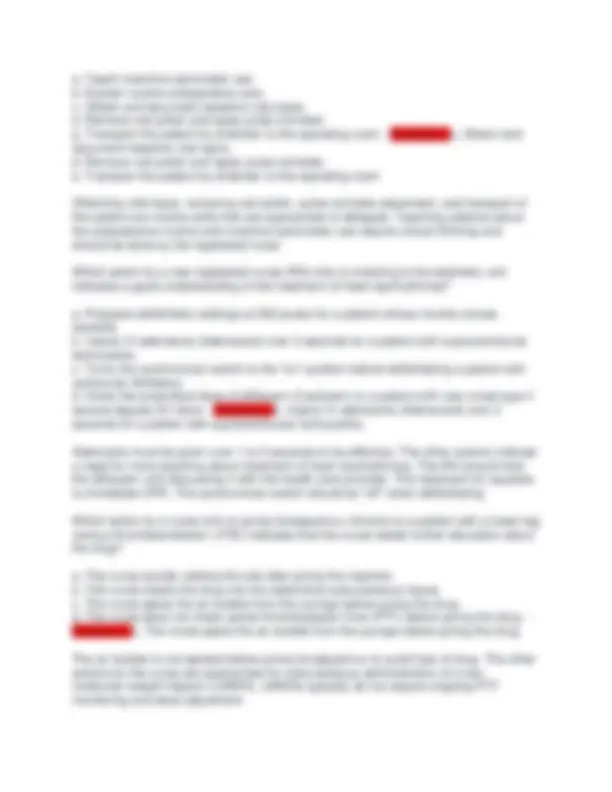
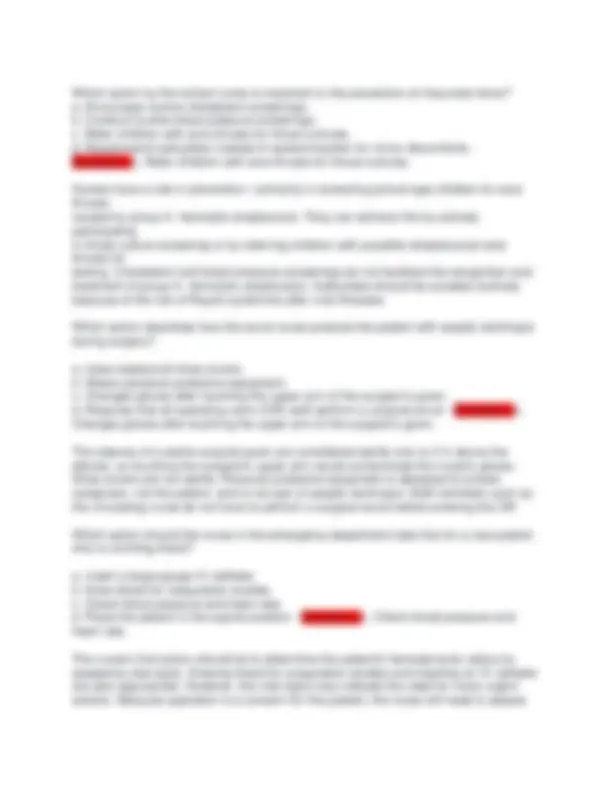
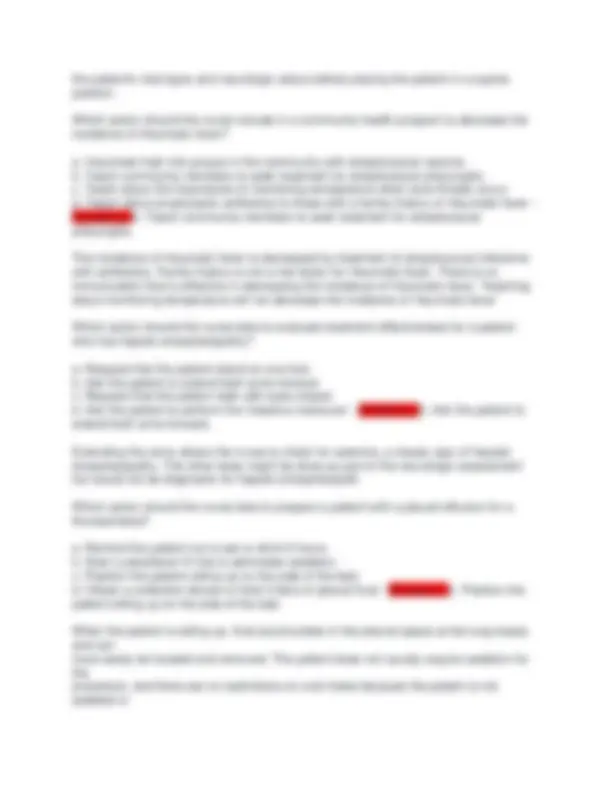
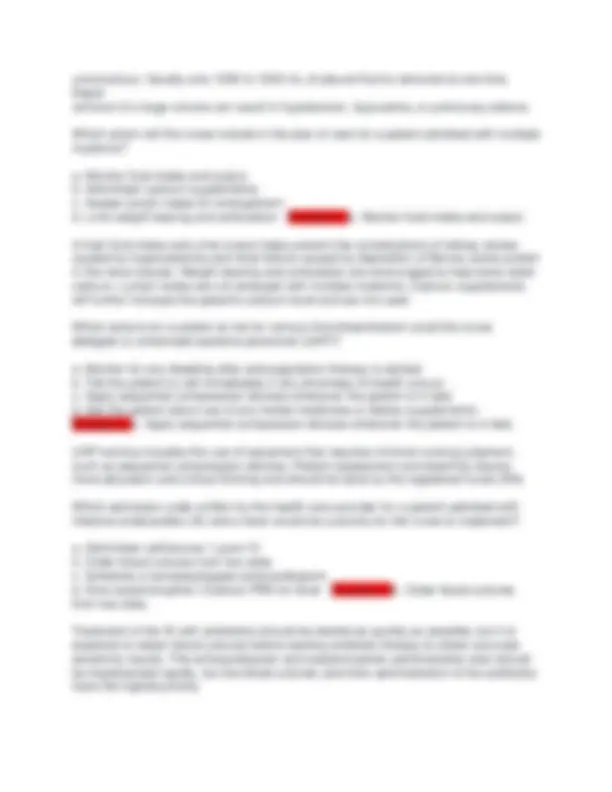
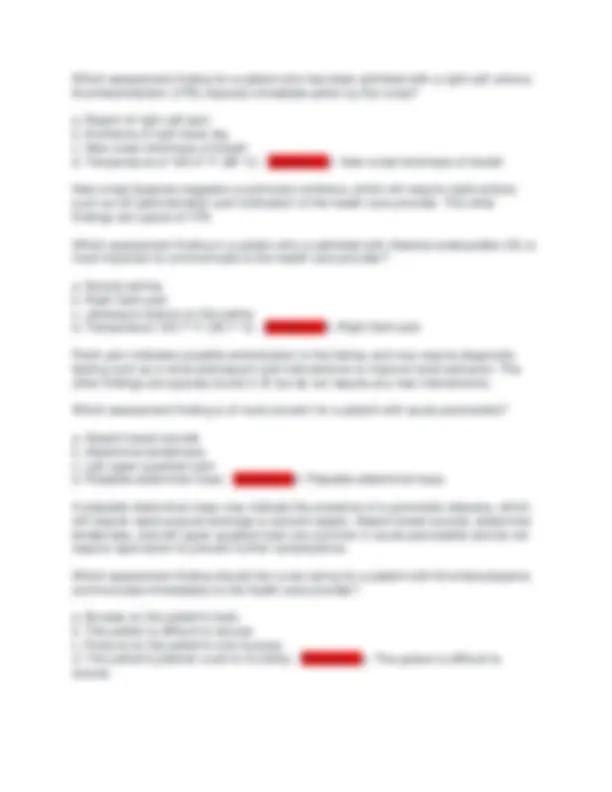
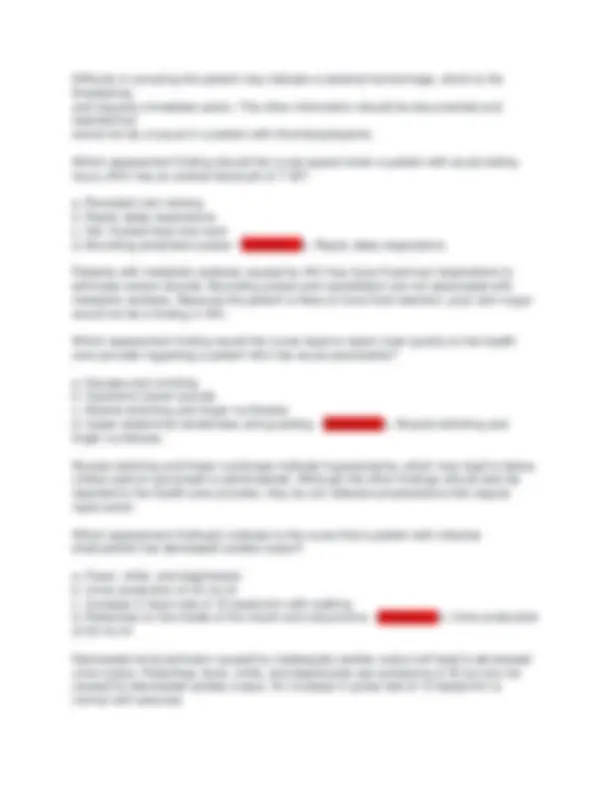
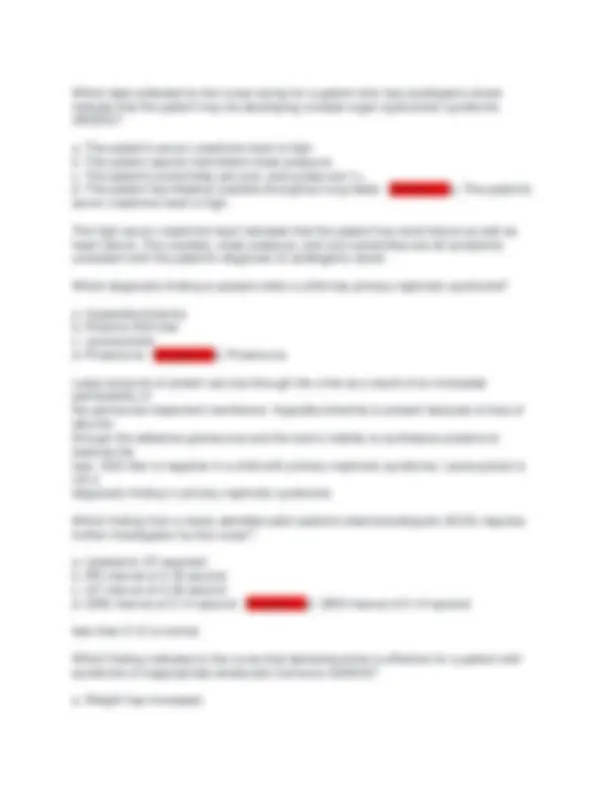
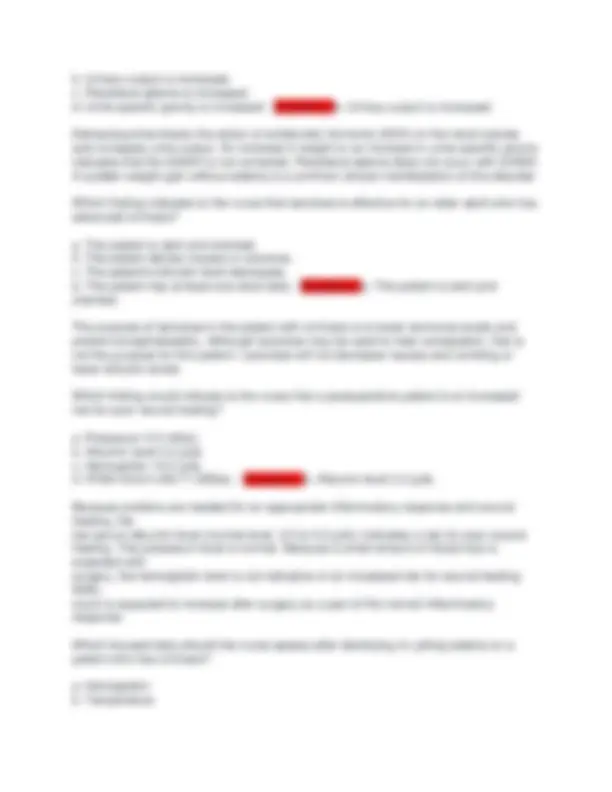
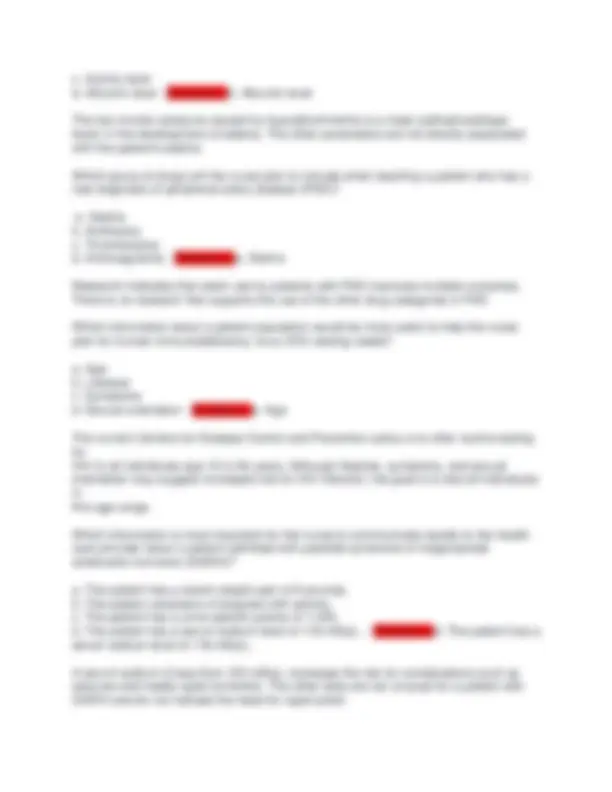
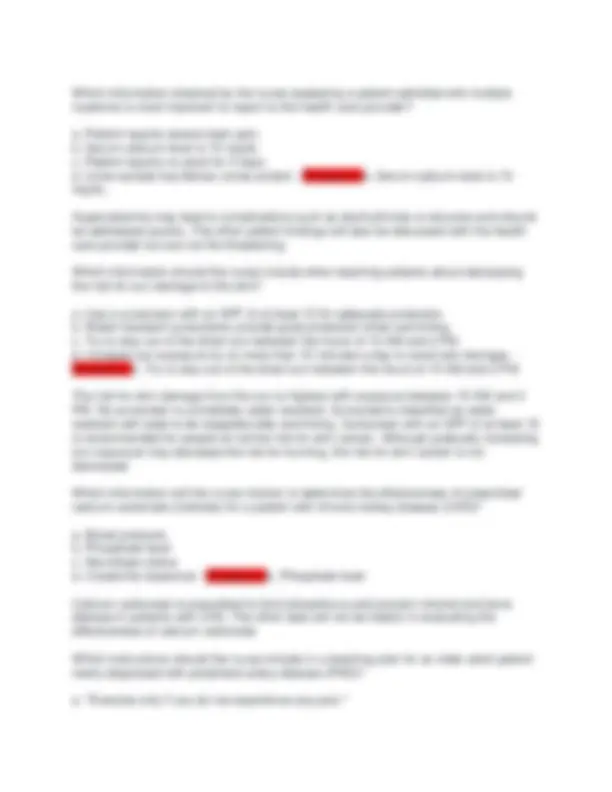
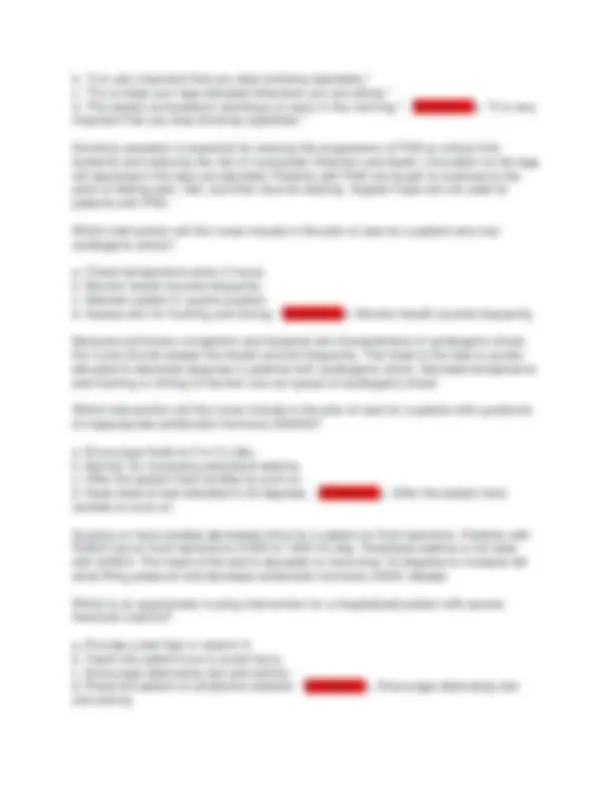
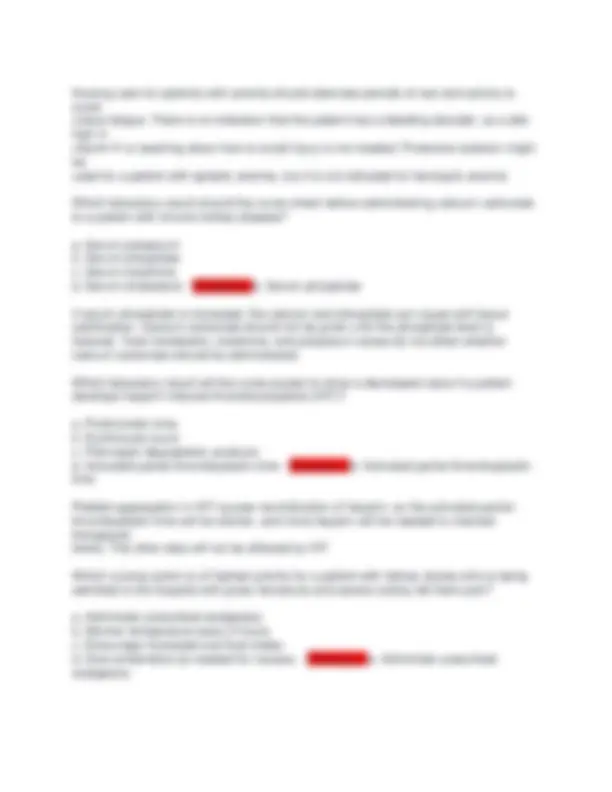
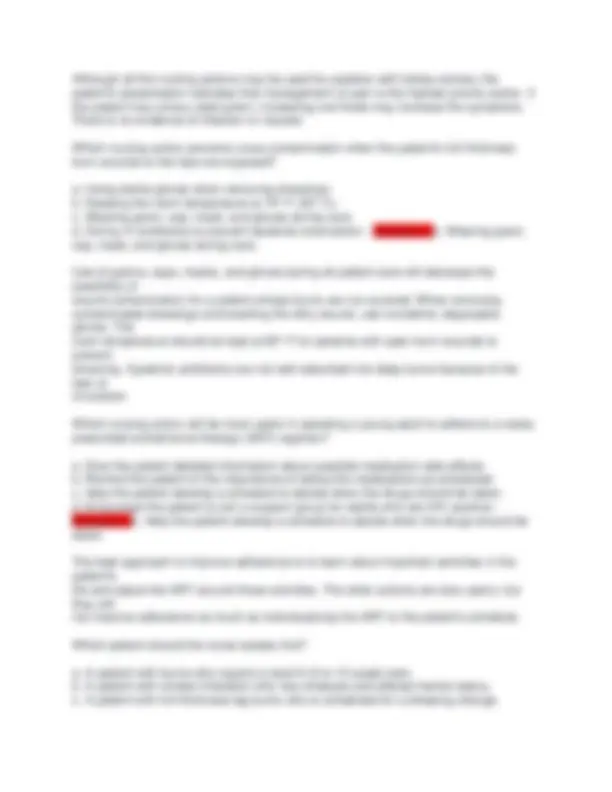
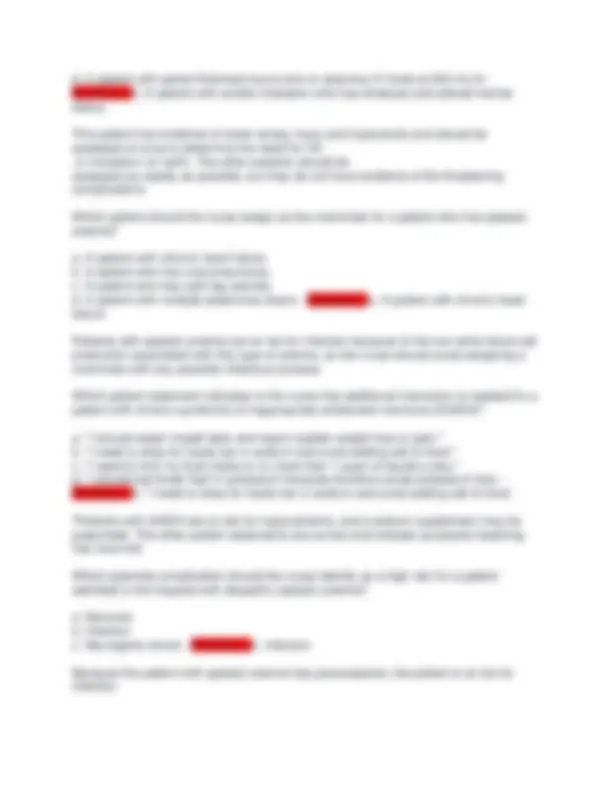
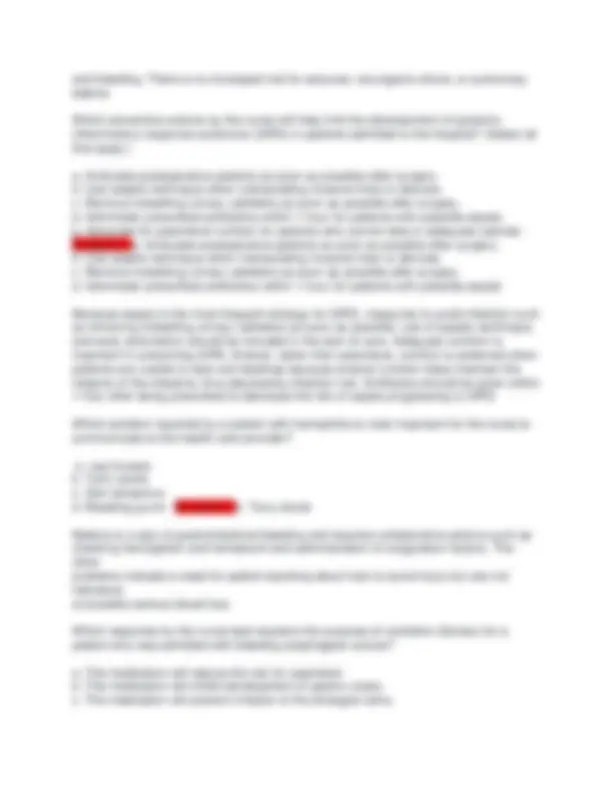
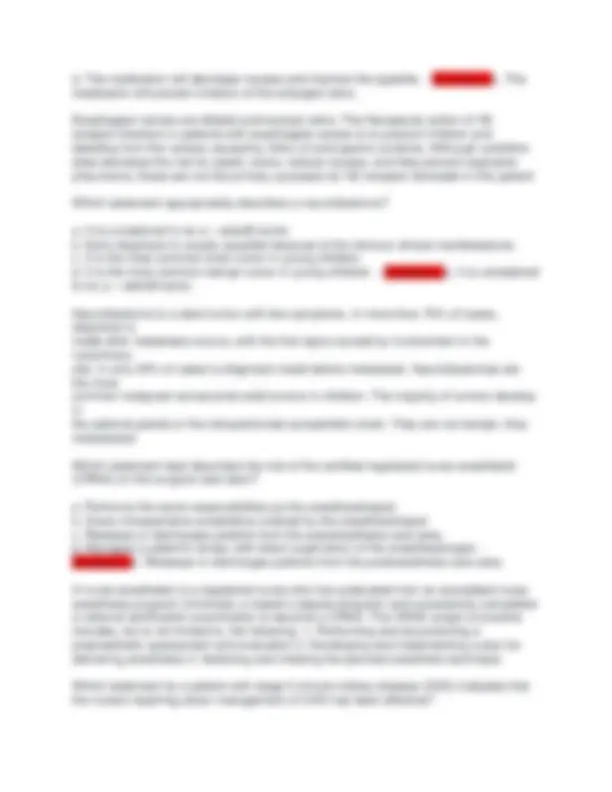
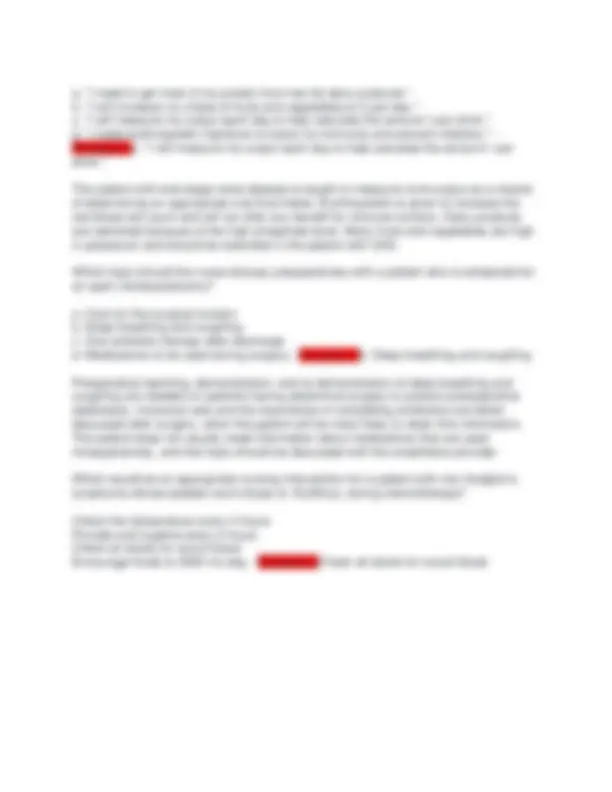


Study with the several resources on Docsity

Earn points by helping other students or get them with a premium plan


Prepare for your exams
Study with the several resources on Docsity

Earn points to download
Earn points by helping other students or get them with a premium plan
Community
Ask the community for help and clear up your study doubts
Discover the best universities in your country according to Docsity users
Free resources
Download our free guides on studying techniques, anxiety management strategies, and thesis advice from Docsity tutors
Advanced Med Surge Final Test Questions 2025 A 19-year-old student comes to the student health center at the end of the semester stating, "My heart is skipping beats." An electrocardiogram (ECG) shows occasional unifocal premature ventricular contractions (PVCs). What action should the nurse take next? a. Insert an IV catheter for emergency use. b. Start supplemental O2 at 2 to 3 L/min via nasal cannula. c. Ask the patient about current stress level and caffeine use. d. Have the patient taken to the nearest emergency department (ED) - Answers>>c. Ask the patient about current stress level and caffeine use. In a patient with a normal heart, occasional PVCs are a benign finding. The timing of the PVCs suggests stress or caffeine as possible etiologic factors. The patient is hemodynamically stable, so there is no indication that the patient needs supplemental O2, an IV, or to be seen in the ED A 19-yr-old woman is brought to the emergency department
Typology: Exams
1 / 75

This page cannot be seen from the preview
Don't miss anything!




































































A 19-year-old student comes to the student health center at the end of the semester stating, "My heart is skipping beats." An electrocardiogram (ECG) shows occasional unifocal premature ventricular contractions (PVCs). What action should the nurse take next? a. Insert an IV catheter for emergency use. b. Start supplemental O2 at 2 to 3 L/min via nasal cannula. c. Ask the patient about current stress level and caffeine use. d. Have the patient taken to the nearest emergency department (ED) - Answers>>c. Ask the patient about current stress level and caffeine use. In a patient with a normal heart, occasional PVCs are a benign finding. The timing of the PVCs suggests stress or caffeine as possible etiologic factors. The patient is hemodynamically stable, so there is no indication that the patient needs supplemental O2, an IV, or to be seen in the ED A 19-yr-old woman is brought to the emergency department with a knife handle protruding from her abdomen. What should the nurse do during the initial assessment of the patient? a. Remove the knife and assess the wound. b. Determine the presence of Rovsing sign. c. Check for circulation and tissue perfusion. d. Insert a urinary catheter and assess for hematuria - Answers>>c. Check for circulation and tissue perfusion. The initial assessment is focused on determining whether the patient has hypovolemic shock. The knife should not be removed until the patient is in surgery, where bleeding can be controlled. Rovsing sign is assessed in the patient with suspected appendicitis. Assessment for bladder trauma is not part of the initial assessment A 3-year-old child is hospitalized after a near-drowning accident. The child's mother complains to the nurse, ―This seems unnecessary when he is perfectly fine. What is the nurse 's best reply? a. ―He still needs a little extra oxygen b. ―I'm sure he is fine, but the doctor wants to make sure c. ―The reason for this is that complications could still occur d. ―It is important to observe for possible central nervous system problems - Answers>>c. ―The reason for this is that complications could still occur
A 33-yr-old male patient with a gunshot wound to the abdomen undergoes surgery, and a colostomy is formed as shown in the accompanying figure. Which information will be included in patient teaching? a. Stool will be expelled from both stomas. b. This type of colostomy is usually temporary. c. Soft, formed stool can be expected as drainage. d. Irrigations can regulate drainage from the stomas - Answers>>b. This type of colostomy is usually temporary. A 56-year-old patient who is disoriented and reports a headache and muscle cramps is hospitalized with syndrome of inappropriate antidiuretic hormone (SIADH). Which initial laboratory result should the nurse expect? a. Elevated hematocrit b. Decreased serum sodium c. Increased serum chloride d. Low urine specific gravity - Answers>>b. Decreased serum sodium When water is retained, the serum sodium level will drop below normal, causing the clinical manifestations reported by the patient. The hematocrit will decrease because of the dilution caused by water retention. Urine will be more concentrated with a higher specific gravity. The serum chloride level will usually decrease along with the sodium level A 78-kg patient in septic shock has a pulse rate of 120 beats/min with low central venous pressure and pulmonary artery wedge pressure. After initial fluid volume resuscitation, the patient's urine output has been 30 mL/hr for the past 3 hours. Which order by the health care provider should the nurse question? a. Administer furosemide (Lasix) 40 mg IV. b. Increase normal saline infusion to 250 mL/hr. c. Give hydrocortisone (Solu-Cortef) 100 mg IV. d. Use norepinephrine to keep systolic BP above 90 mm Hg - Answers>>a. Administer furosemide (Lasix) 40 mg IV. Furosemide will lower the filling pressures and renal perfusion further for the patient with septic shock. Patients in septic shock need large amounts of fluid replacement. If the patient is still hypotensive after initial volume resuscitation with minimally 30 mL/kg, vasopressors such as norepinephrine may be added. IV corticosteroids may be considered for patients in septic shock who cannot maintain an adequate BP with vasopressor therapy despite fluid resuscitation
A nurse is caring for a patient whose hemodynamic monitoring indicates a blood pressure of 92/54 mm Hg, a pulse of 64 beats/min, and a high pulmonary artery wedge pressure (PAWP). Which intervention prescribed by the health care provider should the nurse question? a. Elevate head of bed to 30 degrees. b. Infuse normal saline at 250 mL/hr. c. Hold nitroprusside if systolic BP is less than 90 mm Hg. d. Titrate dobutamine to keep systolic BP is greater than 90 mm Hg - Answers>>b. Infuse normal saline at 250 mL/hr. The patient's elevated PAWP indicates volume excess in relation to cardiac pumping ability, consistent with cardiogenic shock. A saline infusion at 250 mL/hr will worsen the volume excess. The other actions will help to improve cardiac output, which should lower the PAWP and may raise the B A nurse is considering which patient to admit to the same room as a patient who is hospitalized with acute rejection 3 weeks after a liver transplant. Which patient would be the best choice? a. Patient who is receiving chemotherapy for liver cancer b. Patient who is receiving treatment for acute hepatitis C c. Patient who has a wound infection after cholecystectomy d. Patient who requires pain management for chronic pancreatitis - Answers>>d. Patient who requires pain management for chronic pancreatitis The patient with chronic pancreatitis does not present an infection risk to the immunosuppressed patient who had a liver transplant. The other patients either are at risk for infection or currently have an infection, which will place the immunosuppressed patient at risk for infection A patient admitted with burns over 30% of the body surface 2 days ago now has dramatically increased urine output. Which action should the nurse plan to support maintaining kidney function? a. Monitoring white blood cells (WBCs). b. Continuing to measure the urine output. c. Assessing that blisters and edema have subsided. d. Encouraging the patient to eat adequate calories - Answers>>b. Continuing to measure the urine output. The patient' s urine output indicates that the patient is entering the acute phase of the burn injury and moving on from the emergent stage. At the end of the emergent phase, capillary
permeability normalizes, and the patient begins to diurese large amounts of urine with a low specific gravity. Although this may occur at about 48 hours, it may be longer in some patients. Blisters and edema begin to resolve, but this process requires more time. WBCs may increase or decrease, based on the patient's immune status and any i nfectious processes. The WBC count does not indicate kidney function. Although adequate nutrition is important for healing, it does not ensure adequate kidney functioning A patient arrives at the outpatient surgical center for a scheduled laparoscopy under general anesthesia. Which information requires the nurse's preoperative intervention to maintain patient safety? a. The patient has never had general anesthesia. b. The patient is planning to drive home after surgery. c. The patient drank a sip of water 4 hours before arriving. d. The patient's insurance does not cover outpatient surgery. - Answers>>b. The patient is planning to drive home after surgery. After outpatient surgery, the patient should not drive that day and will need assistance with transportation and home care. Clear liquids only require a minimum preoperative fasting period of 2 hours. The patient's experience with anesthesia and the patient's insurance coverage are important to establish, but these are not safety issues A patient arrives in the emergency department with facial and chest burns caused by a house fire. Which action should the nurse take first? a. Auscultate for breath sounds. b. Determine the extent and depth of the burns. c. Give the prescribed hydromorphone (Dilaudid). d. Infuse the prescribed lactated Ringer's solution - Answers>>a. Auscultate for breath sounds. A patient with facial and chest burns is at risk for inhalation injury and assessment of airway and breathing is the priority. The other actions will be completed after airway management is assured A patient being admitted with bacterial meningitis has a temperature of 102.5° F (39.2° C) and a severe headache. Which order should the nurse implement first? a. Administer ceftizoxime (Cefizox) 1 g IV.
The changes in mental status are indicative that the patient is in the progressive stage of shock and that rapid intervention is needed to prevent further deterioration. The other information is consistent with compensatory shock A patient has been diagnosed with urinary tract stones that are high in uric acid. Which foods will the nurse teach the patient to avoid? (Select all that apply.) a. Milk b. Liver c. Spinach d. Chicken e. Cabbage f. Chocolate - Answers>>b. Liver d. Chicken Meats contain purines, which are metabolized to uric acid. The other foods might be restricted in patients who have calcium or oxalate stones A patient has chronic peripheral artery disease (PAD) of the legs and an ulcer on the right second toe. What should the nurse expect to find on assessment? a. Dilated superficial veins. b. Swollen, dry, scaly ankles. c. Prolonged capillary refill in all the toes. d. Serosanguineous drainage from the ulcer - Answers>>c. Prolonged capillary refill in all the toes. Capillary refill is prolonged in PAD because of the slower and decreased blood flow to the periphery. The other listed clinical manifestations are consistent with chronic venous disease A patient has received atropine before surgery and reports a dry mouth. Which action by the nurse is appropriate? a. Check for skin tenting. b. Notify the health care provider. c. Ask the patient about any weakness or dizziness d. Explain that dry mouth is an expected side effect - Answers>>d. Explain that dry mouth is an expected side effect Anticholinergic medications decrease oral secretions, so the patient is taught that a dry mouth is an expected side effect. The dry mouth is not a symptom of dehydration in this case. Therefore, there is no immediate need to check for skin tenting. The health care provider does not need to be notified about an expected side effect. Weakness,
forgetfulness, and dizziness are side effects associated with other preoperative medications such as opioids and benzodiazepines A patient has recently been diagnosed with leukemia. Which of the following symptoms would a health care professional expect to see given this diagnosis? 1.Dyspnea, malaise, and hypotension Paresthesia, facial rash, and abdominal pain Bradycardia, hypotension, and palpitations 4.Bruising, fatigue, and bone pain - Answers>>4.Bruising, fatigue, and bone pain A patient has the following risk factors for melanoma. Which risk factor should the nurse assign as the priority focus of patient teaching? a. The patient has multiple dysplastic nevi. b. The patient uses a tanning booth weekly. c. The patient is fair-skinned with blue eyes. d. The patient's mother died of malignant melanoma - Answers>>b. The patient uses a tanning booth weekly. Because the only risk factor that the patient can change is the use of a tanning booth, the nurse should focus teaching about melanoma prevention on this factor. The other factors also will contribute to increased risk for melanoma A patient is admitted to the hospital with acute rejection of a kidney transplant. Which intervention will the nurse expect for this patient? a. Testing for human leukocyte antigen (HLA) match b. Administration of immunosuppressant medications c. Insertion of an arteriovenous graft for hemodialysis d. Placement of the patient on the transplant waiting list - Answers>>b. Administration of immunosuppressant medications Acute rejection is treated with the administration of additional immunosuppressant drugs such as corticosteroids. Because acute rejection is potentially reversible, there is no sign that the patient will need another transplant or hemodialysis. There is no need to repeat HLA testing A patient is admitted to the postanesthesia care unit (PACU) with a blood pressure (BP) 122/72 mm Hg. Thirty minutes after admission, the BP is 114/62, with a pulse of 74 and warm, dry skin. Which action by the nurse is most appropriate? a. Increase the postoperative IV fluid rate. b. Notify the anesthesia care provider (ACP).
c. Gargle and rinse the mouth several times a day with an antiseptic mouthwash. d. Rinse the mouth before and after each meal and at bedtime with a saline solution - Answers>>d. Rinse the mouth before and after each meal and at bedtime with a saline solution The patient should rinse the mouth with a saline solution frequently. A soft toothbrush is used for oral care. Hydrogen peroxide may damage tissues. Antiseptic mouthwashes may irritate the oral mucosa and are not recommended A patient receiving outpatient chemotherapy for myelogenous leukemia develops an absolute neutrophil count of 850/μL. Which collaborative action should the outpatient clinic nurse anticipate?? a. Discuss the need for hospital admission to treat the neutropenia. b. Teach the patient to administer filgrastim (Neupogen) injections. c. Plan to discontinue the chemotherapy until the neutropenia resolves. d. Order a high-efficiency particulate air (HEPA) filter for the patient's home. - Answers>>b. Teach the patient to administer filgrastim (Neupogen) injections. The patient may be taught to self-administer filgrastim injections. Although chemotherapy may be stopped with severe neutropenia (neutrophil count <500/μL), administration of filgrastim usually allows the chemotherapy to continue. Patients with neutropenia are at higher risk for infection when exposed to other patients in the hospital. HEPA filters are expensive and are used in the hospital, where the number of pathogens is much higher than in the patient's home environment A patient scheduled to undergo total knee replacement surgery under general anesthesia asks the nurse, "Will the doctor put me to sleep with a mask over my face?" Which response by the nurse is most appropriate? a. "Only your surgeon can tell you what method of anesthesia will be used." b. "I will check with the anesthesia care provider to find out what is planned." c. "General anesthesia is given by injecting drugs into your veins, so you will not need a mask over your face." d. "Masks are no longer used for anesthesia. A tube inserted into your throat will deliver gas that puts you to sleep - Answers>>b. "I will check with the anesthesia care provider to find out what is planned." Routine general anesthesia is usually induced by the IV route with a hypnotic, anxiolytic, or dissociative agent. However, general anesthesia may be induced by IV or inhalation. The nurse should consult with the anesthesia care provider to determine the method selected for this patient. The anesthesia care provider will select the method of anesthesia, not the surgeon. Inhalation agents may be given through an endotracheal tube or a laryngeal mask airway
A patient treated for human immunodeficiency virus (HIV) infection for 6 years has developed fat redistribution to the trunk with wasting of the arms, legs, and face. What recommendation will the nurse give to the patient? a. Review foods that are higher in protein. b. Teach about the benefits of daily exercise. c. Discuss a change in antiretroviral therapy. d. Talk about treatment with antifungal agents - Answers>>c. Discuss a change in antiretroviral therapy. A frequent first intervention for metabolic disorders is a change in antiretroviral therapy (ART). Treatment with antifungal agents would not be appropriate because there is no indication of fungal infection. Changes in diet or exercise have not proven helpful for this problem A patient undergoing an emergency appendectomy has been using St. John's wort to prevent depression. Which complication should the nurse expect in the postanesthesia care unit? a. Increased blood pressure b. Increased physical discomfort c. Increased anesthesia recovery time d. Increased postoperative wound bleeding - Answers>>c. Increased anesthesia recovery time St. John's wort may prolong the effects of anesthetic agents and increase the time to waken completely after surgery. It is not associated with increased bleeding risk, hypertension, or increased pain A patient undergoing external radiation has developed a dry desquamation of the skin in the treatment area. The nurse teaches the patient about the management of the skin reaction. Which statement, if made by the patient, indicates the teaching was effective? a. "I can use ice packs to relieve itching." b. "I will scrub the area withwarm water." c. "I will expose my skin to a sun lamp each day." d. "I can buy some aloe vera gel to use on my skin." - Answers>>d. "I can buy some aloe vera gel to use on my skin." Aloe vera gel and cream may be used on the radiated skin area. Ice and sunlamps may injure the skin. Treatment areas should be cleaned gently to avoid further injury A patient who comes to the clinic reports frequent, watery stools for 2 days. Which action should the nurse take first?
b. Calcium level c. Cardiac rhythm d. Neurologic status - Answers>>c. Cardiac rhythm The calcium gluconate helps prevent dysrhythmias that might be caused by the hyperkalemia. The nurse will monitor the other data as well, but these will not be helpful in determining the effectiveness of the calcium gluconate. A patient who has acute myelogenous leukemia (AML) asks the nurse whether the planned chemotherapy will be worth undergoing. Which response by the nurse is appropriate? "If you do not want to have chemotherapy, other treatment options include stem cell transplantation. "The side effects of chemotherapy are difficult, but AML often goes into remission with chemotherapy." "The decision about treatment is one that you and the doctor need to make rather than asking what I would do." - Answers>>"The side effects of chemotherapy are difficult, but AML often goes into remission with chemotherapy." A patient who has acute myelogenous leukemia (AML) is considering treatment with a hematopoietic stem cell transplant (HSCT). What is the best approach for the nurse to assist the patient with this treatment decision? a. Discuss the need for insurance to cover post-HSCT care. b. Inquire whether there are questions or concerns about HSCT. c. Emphasize the positive outcomes of a bone marrow transplant. d. Explain that a cure is not possible with any treatment except HSCT - Answers>>b. Inquire whether there are questions or concerns about HSCT. Offering the patient an opportunity to ask questions or discuss concerns about HSCT will encourage the patient to voice concerns about this treatment and will allow the nurse to assess whether the patient needs more information about the procedure. Treatment of AML using chemotherapy is another option for the patient. It is not appropriate for the nurse to ask the patient to consider insurance needs in making this decision. A patient who has bacterial meningitis is disoriented and anxious. Which nursing action will be included in the plan of care? a. Encourage family members to remain at the bedside. b. Apply soft restraints to protect the patient from injury. c. Keep the room well-lighted to improve patient orientation. d. Minimize contact with the patient to decrease sensory input - Answers>>a. Encourage family members to remain at the bedside.
Patients with meningitis and disorientation will be calmed by the presence of someone familiar at the bedside. Restraints should be avoided because they increase agitation and anxiety. The patient requires frequent assessment for complications. The use of touch and a soothing voice will decrease anxiety for most patients. The patient will have photophobia, so the light should be dim. A patient who has been receiving diuretic therapy is admitted to the emergency department with a serum potassium level of 3.0 mEq/L. The nurse should alert the health care provider immediately that the patient is on which medication? a. Digoxin (Lanoxin) 0.25 mg/day b. Ibuprofen 400 mg every 6 hours c. Lantus insulin 24 U every evening d. Metoprolol (Lopressor) 12.5 mg/day - Answers>>a. Digoxin (Lanoxin) 0.25 mg/day Hypokalemia increases the risk for digoxin toxicity, which can cause serious dysrhythmias. The nurse will need to do more assessment about the other medications, but they are not of as much concern with the potassium level A patient who has been receiving IV heparin infusion and oral warfarin (Coumadin) for a deep vein thrombosis (DVT) is diagnosed with heparin-induced thrombocytopenia (HIT) when the platelet level drops to 110,000/μL. Which action will the nurse include in the plan of care? a. Prepare for platelet transfusion. b. Discontinue the heparin infusion. c. Administer prescribed warfarin (Coumadin). d. Give low-molecular-weight heparin (LMWH) - Answers>>b. Discontinue the heparin infusion. All heparin is discontinued when HIT is diagnosed. The patient should be instructed to never receive heparin or LMWH. Warfarin is usually not given until the platelet count has returned to 150,000/μL. The platelet count does not drop low enough in HIT for a platelet transfusion, and platelet transfusions increase the risk for thrombosis A patient who has burns on the arms, legs, and chest from a house fire has become agitated and restless 8 hours after being admitted to the hospital. Which action should the nurse take first? a. Stay at the bedside and reassure the patient. b. Administer the ordered morphine sulfate IV. c. Assess orientation and level of consciousness. d. Use pulse oximetry to check oxygen saturation - Answers>>d. Use pulse oximetry to check oxygen saturation
a. Notify the anesthesia care provider. b. Cover the patient with a warm blanket. c. Hold opioid analgesics until the patient is warmer. d. Give acetaminophen 650 mg suppository rectally - Answers>>b. Cover the patient with a warm blanket. The patient assessment indicates the need for active rewarming. There is no indication of a need for acetaminophen. Opioid analgesics may help reduce shivering. Because hypothermia is common and expected in the immediate postoperative period, there is no need to notify the anesthesia care provider unless the patient continues to be hypothermic after active rewarming. A patient who has non-Hodgkin's lymphoma is receiving combination treatment with rituximab (Rituxan) and chemotherapy. Which patient assessment finding requires the most rapid action by the nurse? a. Anorexia b. Vomiting c. Oral ulcers d. Lip swelling - Answers>>d. Lip swelling Lip swelling in angioedema may indicate a hypersensitivity reaction to the rituximab. Thenurse should stop the infusion and further assess for anaphylaxis. The other findings mayoccur with chemotherapy but are not immediately life threatening A patient who is diagnosed with acquired immunodeficiency syndrome (AIDS) tells the nurse, "I feel obsessed with morbid thoughts about dying." Which response by the nurse is appropriate? a. "Thinking about dying will not improve the course of AIDS." b. "Do you think that taking an antidepressant might be helpful?" c. "Can you tell me more about the thoughts that you are having?" d. "It is important to focus on the good things about your life now." - Answers>>c. "Can you tell me more about the thoughts that you are having?" More assessment of the patient's psychosocial status is needed before taking any other action. The statements, "Thinking about dying will not improve the course of AIDS" and "It is important to focus on the good things in life" or suggesting an antidepressant discourage the patient from sharing any further information with the nurse and decrease the nurse's ability to develop a trusting relationship with the patient A patient who is diagnosed with cervical cancer classified as Tis, N0, M0 asks the nurse what the letters and numbers mean. Which response by the nurse is accurate?
a. "The cancer involves only the cervix." b. "The cancer cells look like normal cells." c. "Further testing is needed to determine the spread of the cancer." d. "It is difficult to determine the original site of the cervical cancer. - Answers>>a. "The cancer involves only the cervix." Cancer in situ indicates that the cancer is localized to the cervix and is not invasive at this time. Cell differentiation is not indicated by clinical staging. Because the cancer is in situ, the origin is the cervix. Further testing is not indicated given that the cancer has not spread A patient who is lethargic and with deep, rapid respirations has the following arterial blood gas (ABG) results: pH 7.32, PaO2 88 mm Hg, PaCO2 35 mm Hg, and HCO3 16 mEq/L. How should the nurse interpret these results? a. Metabolic acidosis b. Metabolic alkalosis c. Respiratory acidosis d. Respiratory alkalosis - Answers>>a. Metabolic acidosis A patient who is taking a potassium-wasting diuretic for treatment of hypertension reports generalized weakness. Which action is appropriate for the nurse to take? a. Assess for facial muscle spasms. b. Ask the patient about loose stools. c. Recommend the patient avoid drinking orange juice with meals. d. Suggest that the health care provider order a basic metabolic panel - Answers>>d. Suggest that the health care provider order a basic metabolic panel Generalized weakness is a manifestation of hypokalemia. After the health care provider orders the metabolic panel, the nurse should check the potassium level. Facial muscle spasms might occur with hypocalcemia. Orange juice is high in potassium and would be advisable to drink if the patient is hypokalemic. Loose stools are associated with hyperkalemia A patient who is unconscious has ineffective cerebral tissue perfusion and cerebral tissue swelling. Which nursing intervention will be included in the plan of care? a. Encourage coughing and deep breathing. b. Position the patient with knees and hips flexed. c. Keep the head of the bed elevated to 30 degrees. d. Cluster nursing interventions to provide rest periods - Answers>>c. Keep the head of the bed elevated to 30 degrees.
d. Respiratory alkalosis - Answers>>d. Respiratory alkalosis The pH indicates that the patient has alkalosis and the low PaCO2 indicates a respiratory cause. The other responses are incorrect based on the pH and the normal HCO3. A patient with a head injury develops SIADH. Manifestations the nurse would expect to find include a. hypernatremia and edema. b. muscle spasticity and hypertension. c. low urine output and hyponatremia. d. weight gain and decreased glomerular filtration rate. - Answers>>c. low urine output and hyponatremia. A patient with a possible pulmonary embolism reports chest pain and difficulty breathing. The nurse finds a heart rate of 142 beats/min, blood pressure of 100/60 mm Hg, and respirations of 42 breaths/min. Which action should the nurse take first? a. Administer anticoagulant drug therapy. b. Notify the patient's health care provider. c. Prepare patient for a spiral computed tomography (CT). d. Elevate the head of the bed to a semi-Fowler's position - Answers>>d. Elevate the head of the bed to a semi-Fowler's position The patient has symptoms consistent with a pulmonary embolism (PE). Elevating the head of the bed will improve ventilation and gas exchange. The other actions can be performed after the head is elevated and O2 is started. The health care provider may order a spiral CT to identify PE. Anticoagulants may be ordered after confirmation of the diagnosis of PE A patient with a tracheostomy has a new order for a fenestrated tracheostomy tube. Which action should the nurse include in the plan of care in collaboration with the speech therapist? a. Leave the tracheostomy inner cannula inserted at all times. b. Place the decannulation cap in the tube before cuff deflation. c. Assess the ability to swallow before using the fenestrated tube. d. Inflate the tracheostomy cuff during use of the fenestrated tube - Answers>>c. Assess the ability to swallow before using the fenestrated tube. Because the cuff is deflated when using a fenestrated tube, the patient's risk for aspiration
should be assessed before changing to a fenestrated tracheostomy tube. The decannulation cap is never inserted before cuff deflation because to do so would obstruct the patient's airway. The cuff is deflated and the inner cannula removed to allow air to flow across the pat ient's vocal cords when using a fenestrated tube A patient with blunt abdominal trauma from a motor vehicle crash undergoes peritoneal lavage. If the lavage returns brown fecal drainage, which action will the nurse plan to take next? a. Auscultate the bowel sounds. b. Prepare the patient for surgery. c. Check the patient's oral temperature. d. Obtain information about the accident - Answers>>b. Prepare the patient for surgery. Return of brown drainage and fecal material suggests perforation of the bowel and the need for immediate surgery. Auscultation of bowel sounds, checking the temperature, and obtaining information about the accident are appropriate actions, but the priority is to prepare to send the patient for emergency surgery A patient with cancer is eating very little due to altered taste sensation. Which nursing action would address the cause of the patient problem? a. Add protein powder to foods such as casseroles. b. Tell the patient to eat foods that are high in nutrition .c. Avoid giving the patient foods that are strongly disliked. d. Add spices to enhance the flavor of foods that are served. - Answers>>.c. Avoid giving the patient foods that are strongly disliked. The patient will eat more if disliked foods are avoided and foods that the patient likes are included instead. Additional spice is not usually an effective way to enhance taste. Adding protein powder does not address the issue of taste. The patient's poor intake is not caused by a lack of information about nutrition. A patient with cardiogenic shock has the following vital signs: BP 102/50, pulse 128, respirations 28. The pulmonary artery wedge pressure (PAWP) is high, and cardiac output is low. Which treatment would the nurse expect to be prescribed? a. Furosemide b. Hydrocortisone c. Epinephrine drip d. 5% albumin infusion - Answers>>a. Furosemide